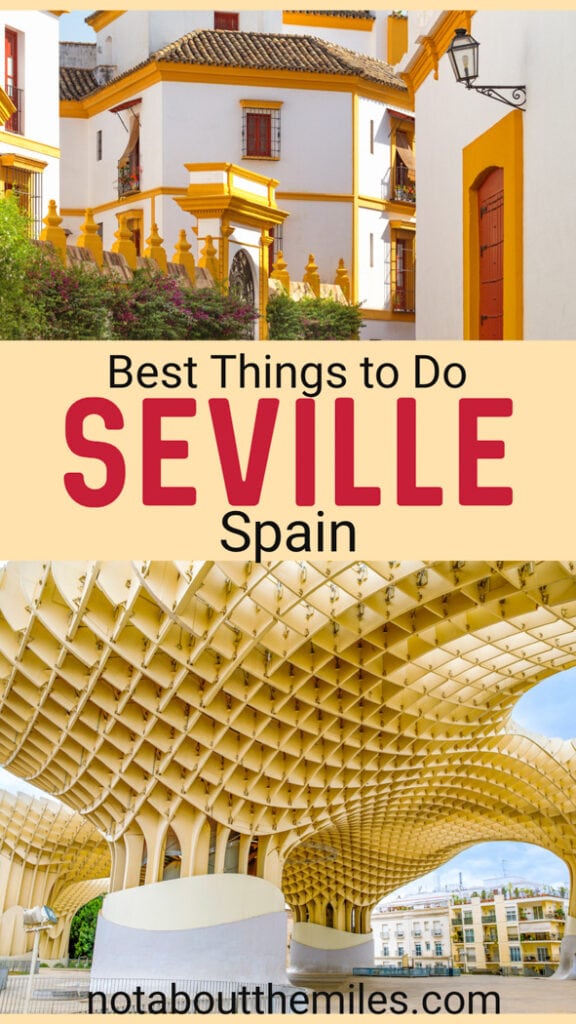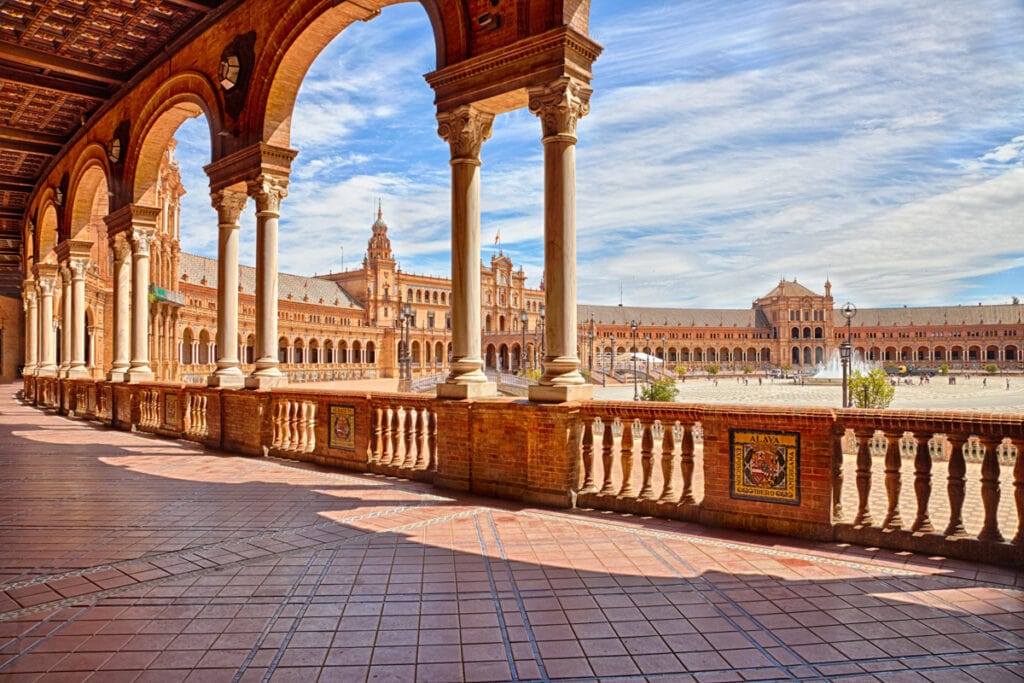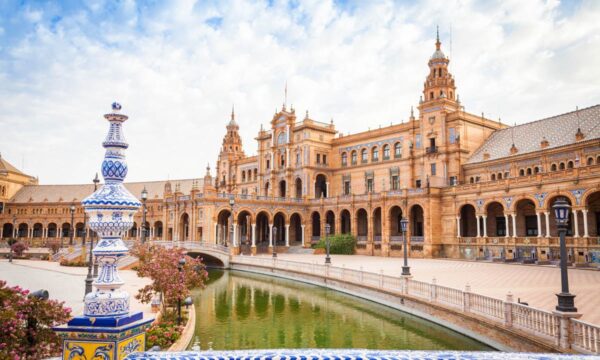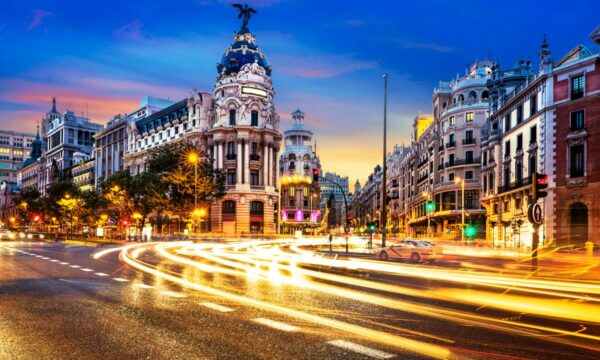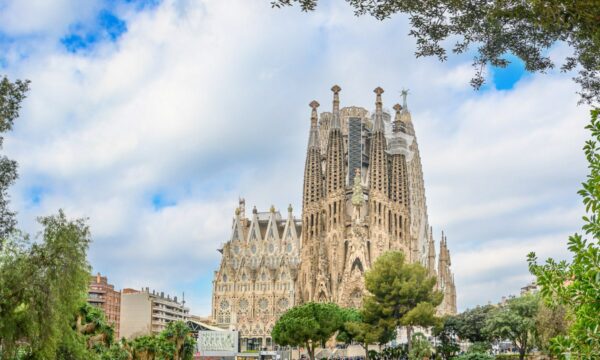Planning a trip to Seville, Spain? Prepare to be spoiled for choice on things to do in Seville: the Andalusian city offers many beautiful sights, a rich history, and loads of ambience.
Without question, Seville is one of the most beautiful places to visit in Spain!
In this first-timers’ guide to Seville, you will discover the best things to do in Seville.
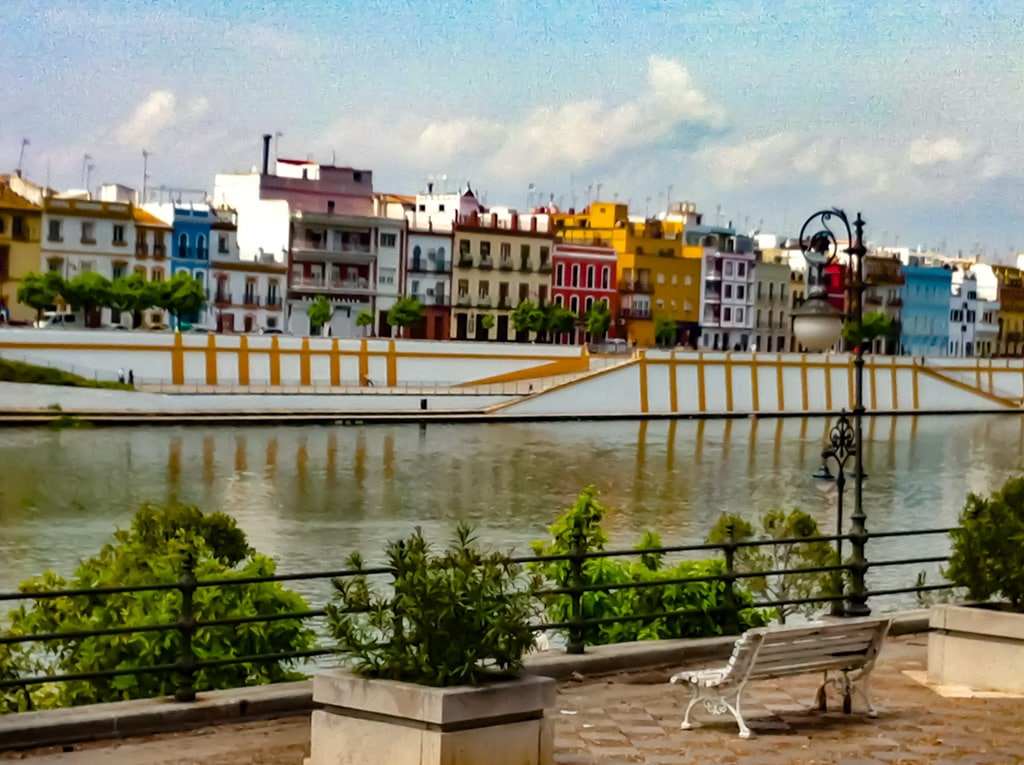
Some links on this page may be affiliate links. If you click an affiliate link and make a purchase, we may receive a small commission, at no extra cost to you. For more details, refer to our disclosure.
A Brief Overview of Seville
Located on the Guadalquivir River, Seville boasts one of the largest historic centers in Europe, with a UNESCO World Heritage Site. It’s walkable and a lot of fun to explore.
Among Seville’s must-visit sights are the Royal Alcazar, with its remarkable Mudéjar architecture, the gigantic Seville Cathedral, and the magnificent Plaza de España, one of the most impressive squares in Spain.
Be enthralled by the fancy footwork and mesmerizing music of the flamenco art form. There are many venues in the historic center from which to pick.
Sample a dizzying variety of tapas: there are more than 3,000 tapas bars in the city, from traditional to modern! And try orange wine or tinto de verano.
From streets lined with orange trees to squares exuding old-world charm, Seville is one of the best cities in Europe you can visit, and a must on any Spain itinerary.
While the scent of citrus and lively festivals make spring a wonderful time of year to visit Seville, the city’s mild winter temperatures and many sunny days also make winter in Seville enticing.
Excited? Let’s get started discovering the best things to do in Seville!
The Best Things to Do in Seville
1. Explore the Royal Alcazar of Seville
Exploring the Royal Alcazar of Seville, with its beautiful palaces and gorgeous gardens, is definitely one of the best things to do in Seville!
The Alcazar of Seville is our favorite monument in Andalusia: we think it’s almost as beautiful as the famous Alhambra of Granada.
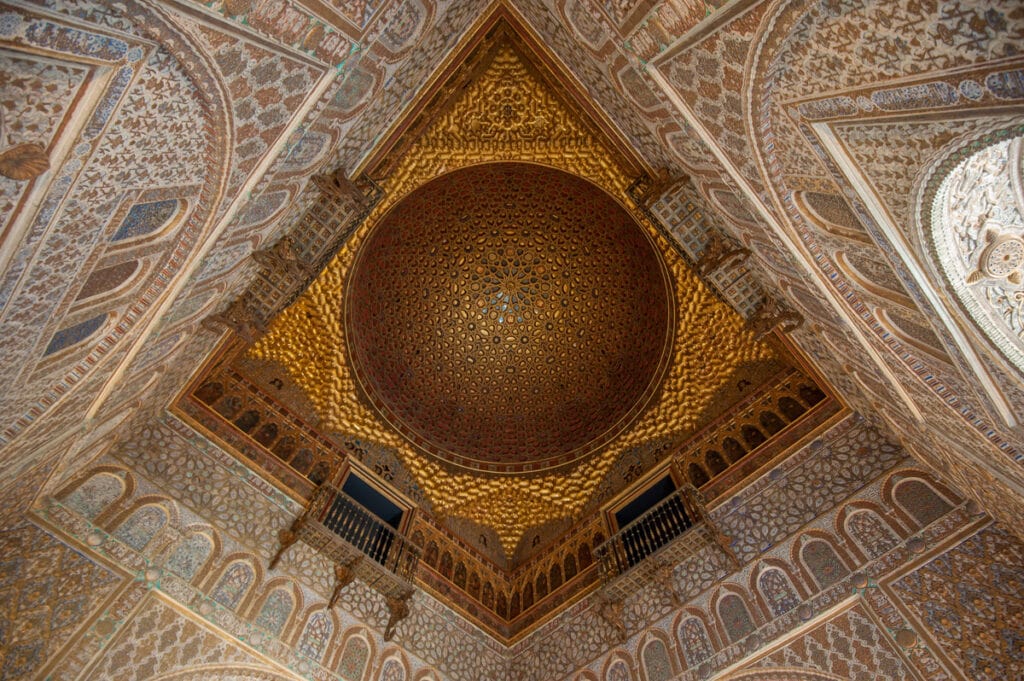
The first fort here was built in the 10th century by the Caliph of Al-Andalus, and over the 11th and 12th centuries, the Abbadids and the Almohads expanded the fortress complex and built many palaces and other structures.
Only a few of the structures from the Islamic era still remain.
In the middle of the 13th century, the Christians conquered Seville, and the Alcazar became the residence of the Christian monarchs.
King Pedro I built the Mudejar Palace, a fabulous example of the Andalusian Mudejar style of architecture. The Catholic rulers Isabella and Fernando added to the upper floor, which became the main royal residence.
Even today, the Spanish royal family stay here when they visit Seville.
The Alcazar complex is a blend of many architectural styles, from Gothic and Romanesque to Renaissance and Baroque, with extensive use of Islamic decoration. The result is a complex that will leave you gawking.
From the tile work on the main gate, the Puerta del León, to the lacy arches and reflecting pool of the Patio de las Doncellas (Courtyard of the Maidens), and the stunning ceiling of the Salon de Embajadores, there’s a lot to see and admire at the Alcazar.
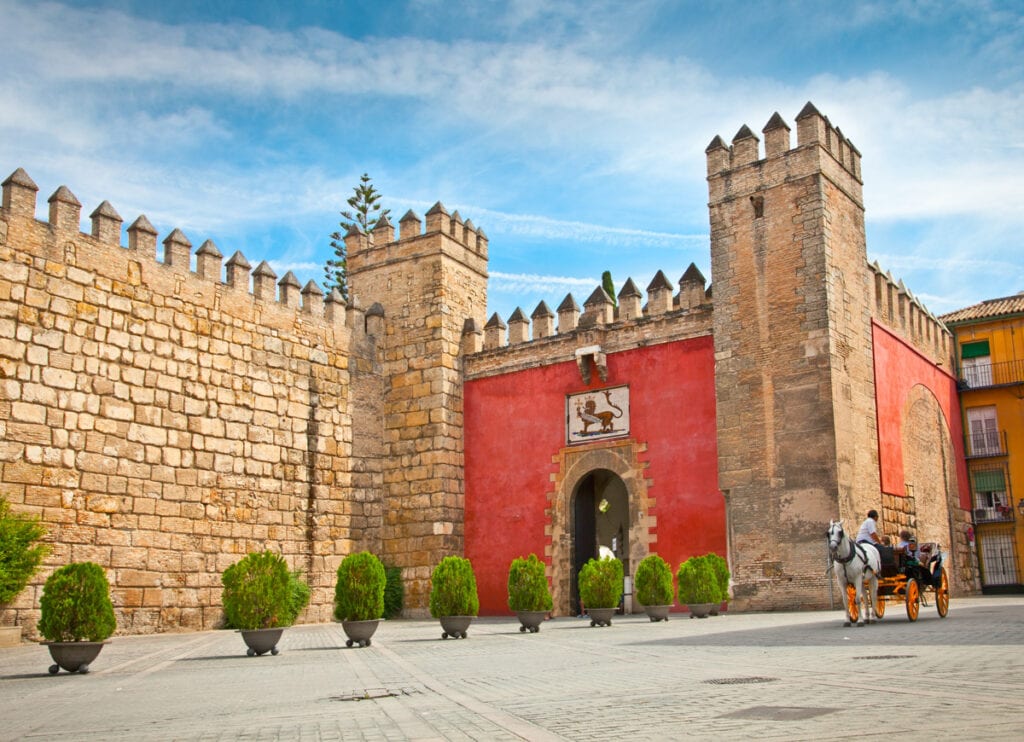
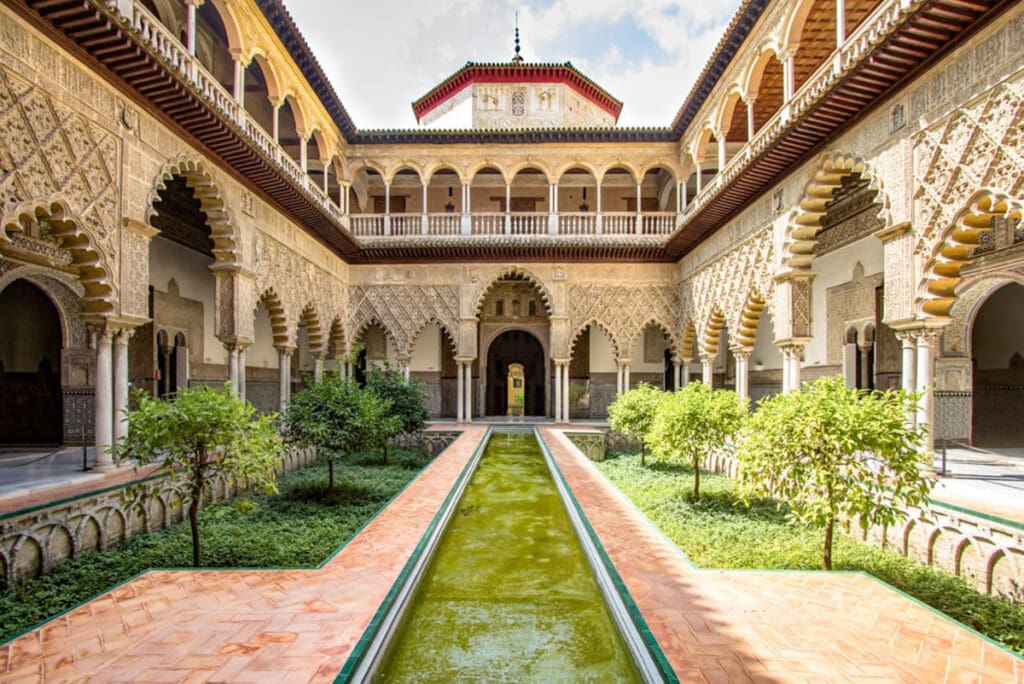
The gardens at the Reales Alcazares de Sevilla are gorgeous. They include formal gardens with boxed hedges, tall palms, an orangerie, a maze, and many water features, including the Mercury Pond. There are peacocks, too!
A gallery, added in the 17th century, overlooks the gardens and offers wonderful views.
And don’t miss the Baths of Doña María de Padilla, one of the most photographed spots in the complex!
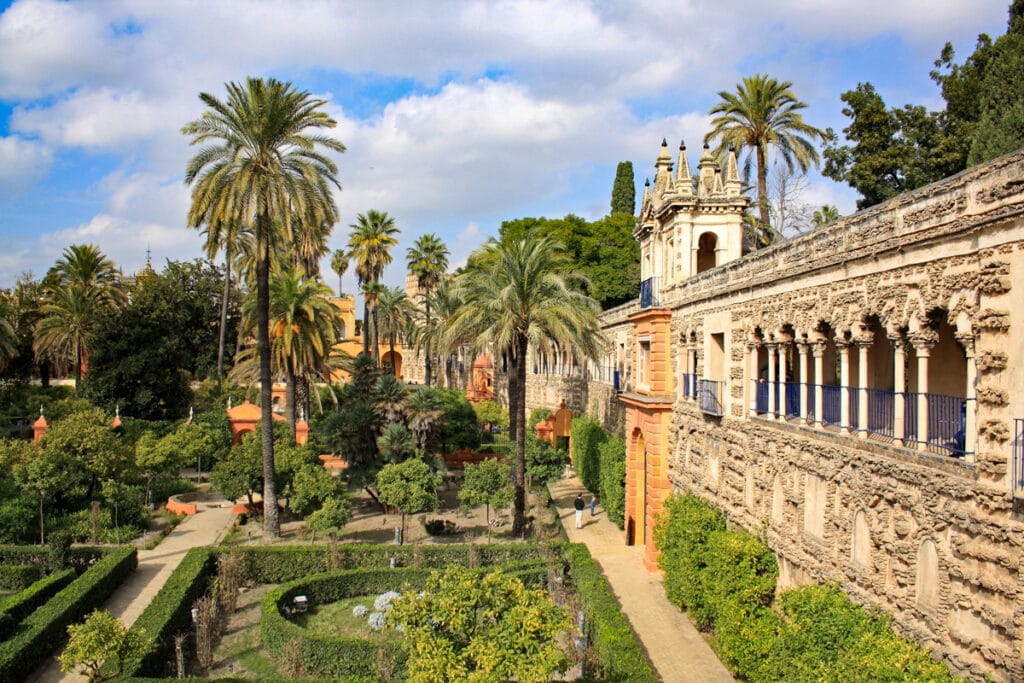
For Game of Thrones fans, the Alcazar of Seville served as the filming location for the Water Gardens of Dorne.
If you want to explore on your own, be sure to book tickets online in advance. Pay for the audio guide and map. Tickets can also be bought at the official site.
We suggest investing in a highly-rated guided tour. The Alcazar is one of the bucket-list Seville attractions, and a knowledgable local guide can elevate your experience significantly!
Book your guided tour of the Royal Alcazar of Seville today!
And for an even more special experience, consider this morning tour of the Alcazar that allows you to enter before the general public for one glorious hour! Or this reduced group tour with a historian guide for a more immersive experience.
Pro tip: Bring your passport or another photo ID: you’ll be asked to show it for entry.
Pro tip: Visit early or late in the day, especially in season, to avoid crowds.
2. Visit the Seville Cathedral
Visiting the Seville Cathedral is one of the top things to do in Seville.
After the Christians conquered Seville in 1248, they converted the large Almohad mosque into the city’s cathedral.
Seville became a trading powerhouse in the decades following the Reconquista. In July 1401, wanting to show off the wealth of the city, Seville’s leaders decided to build a magnificent cathedral, at the same site.
Local lore has it that at the meeting, they said: “Let us build a church so beautiful and so grand that those who see it finished will take us for mad.”
Construction on the Cathedral was delayed, but eventually began in 1434, and it was completed in 1506. It became the largest cathedral in the world at the time.
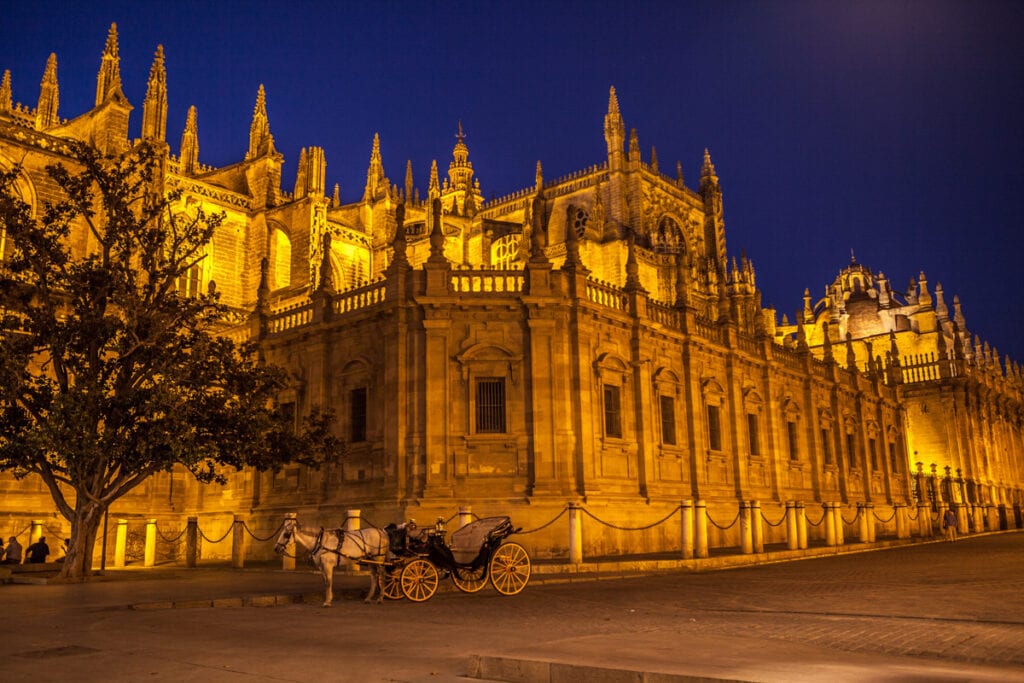
The Seville Cathedral is still one of the largest churches in the world, and the largest Gothic church. Its spires are stunning, and it has the longest nave of any church on the planet. There are 15 entrances!
The interior of the Seville Cathedral will leave you gaping in awe. There are 80 chapels, and a wealth of religious art to admire, including works by the likes of Goya and Murillo.
Capilla Mayor, the dazzling main chapel, has an enormous altarpiece that features scenes from the life of Christ, carved in wood and entirely covered in gold. It’s said to be the life work of just one artist, Pierre Dancart.
Also in the cathedral is the impressive tomb of Christopher Columbus, held aloft by four figures representing the four kingdoms of Spain during his time.
The Seville Cathedral is one of three sites that make up Seville’s UNESCO World Heritage Site: the other two are the Royal Alcazar of Seville and the General Archive of the Indies.
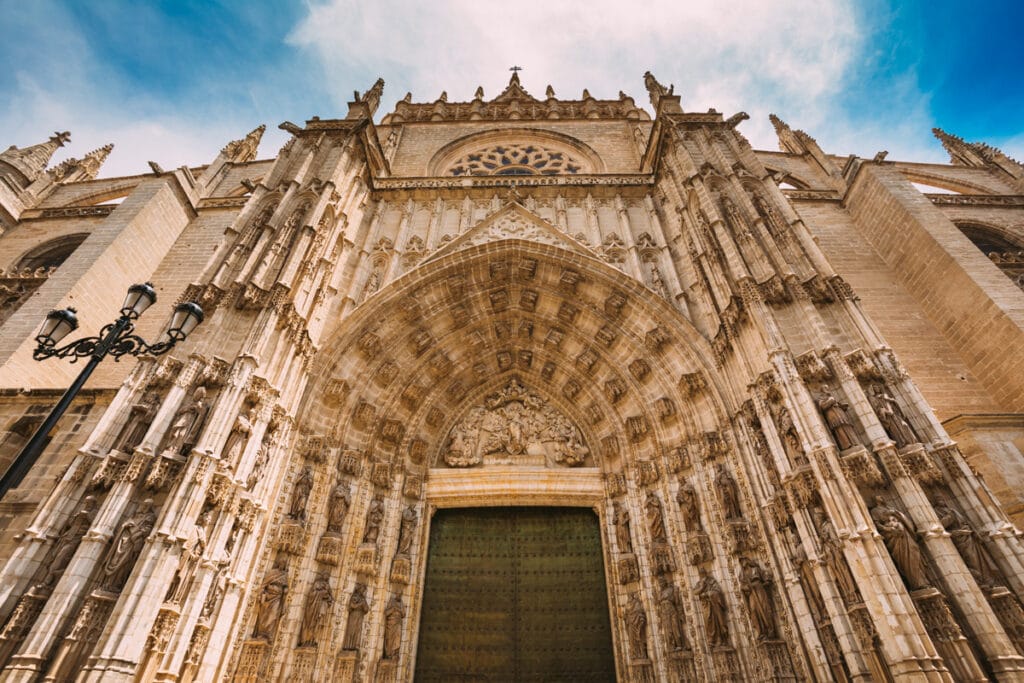
Before or after your visit, be sure to linger a while in the lovely Courtyard of the Oranges, where tours normally start and end. In the spring, you can enjoy the sweet scent of citrus blossom wafting through the courtyard.
Buy skip-the-line tickets for the cathedral and the bell tower online to avoid long waits. You can also opt for an audio guide.
Or take a guided tour: this popular tour allows you to choose one or more options from the Cathedral, the bell tower, and the Royal Alcazar.
Pro Tip: Wear appropriate attire: no hats or visors, no beach shoes, no vest or tank tops, and no short skirts or shorts.
3. Enjoy the Views from La Giralda, the Bell Tower
For panoramic views over the city of Seville, head to the top of La Giralda, the bell tower of the Seville Cathedral.
The tower is 104.1.m (342 feet) tall, and is one of Seville’s most beloved landmarks.
The bell tower used to be the minaret for the Great Mosque of Seville. It was built in the 12th century, using local bricks and marble from other monuments.
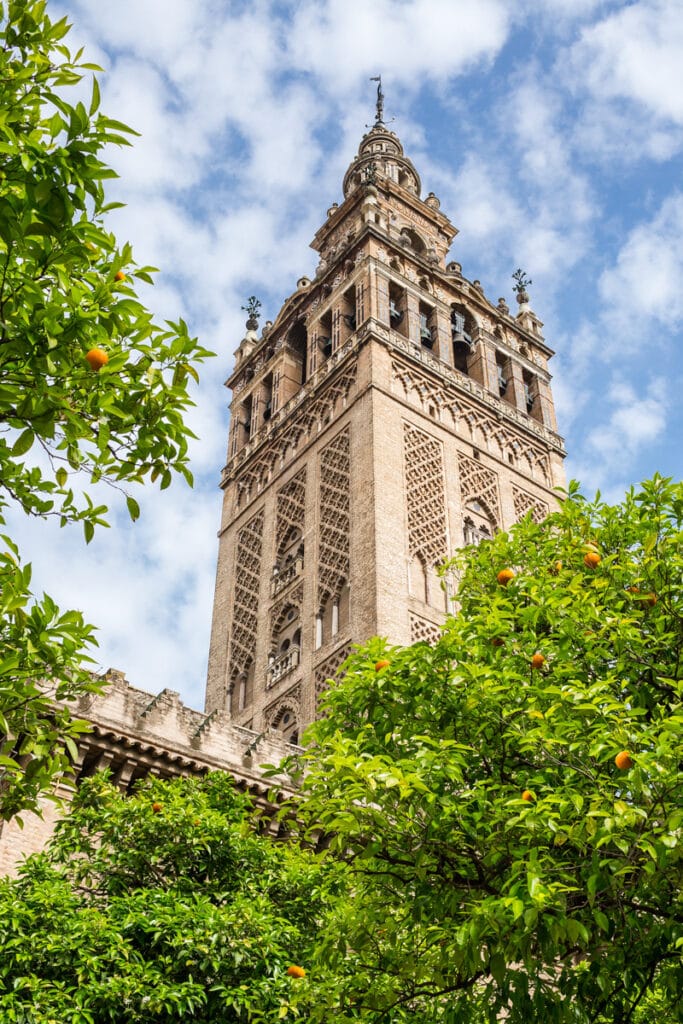
When the Seville Cathedral was built, the Christians retained the minaret, converting it into a bell tower with the addition of a belfry in the 16th century. The belfry is built in Renaissance style.
The rotating sculpture at the top, a woman bearing a flagpole, was added in 1568, and is known as the Giraldillo (weather vane). It gives the bell tower its name, La Giralda.
Instead of stairs, there are 34 ramps that lead to the top of the tower, with some steps at the very end. The ramps were meant to allow horses or mules to ascend to the top.
Although much easier than many other bell towers we’ve climbed in Europe, it’s still a trudge to the top, and we saw several people taking advantage of respite stops along the way.
From the viewing tower, you get expansive panoramas over Seville in all directions. Plus, you get up close looks at the spires and buttresses of the Gothic cathedral.
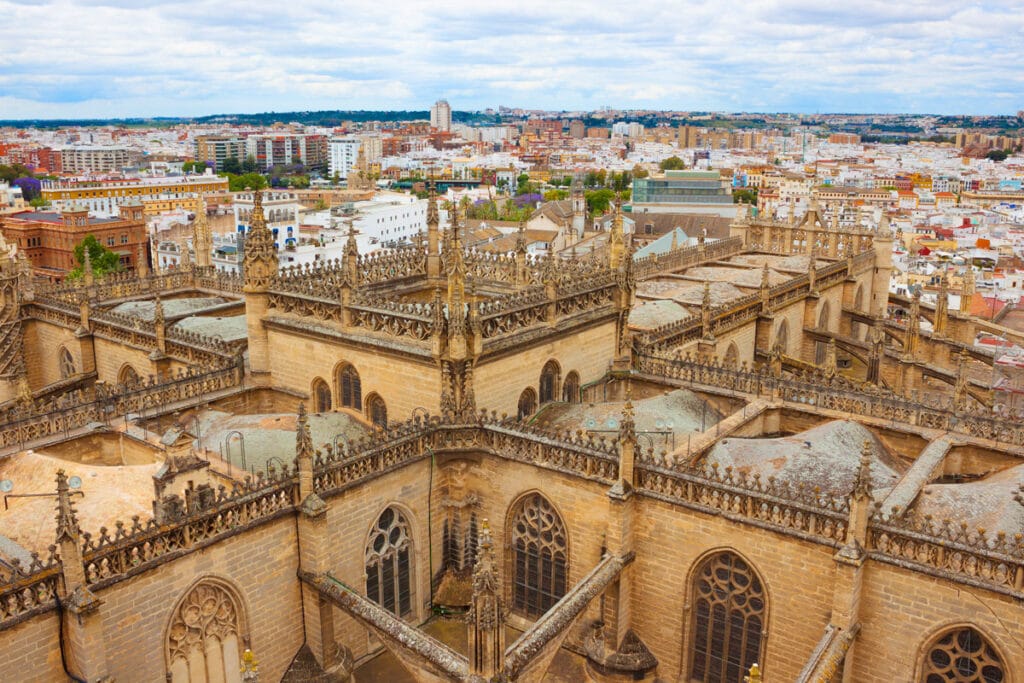
There are viewpoints en route to the top of the tower if you feel you do not want to climb all the way up, although the views are best from the top. The tower also looks fantastic from the street, if you do not want to climb at all.
The bells are pretty loud if you are at the top when they ring out, every 15 minutes.
Entry to La Giralda is included in the ticket to the Seville Cathedral.
4. Take the Seville Hop On, Hop Off Bus Tour
There are many sights to visit in Seville, and your steps can add up each day if you walk everywhere.
The Hop On, Hop Off bus is a great way to accomplish your Seville sightseeing in an efficient manner, especially if you plan to visit Seville for just one or two days.
It’s also a great transport option if you visit in the winter, or when it’s raining!
The tour starts at the Paseo de Colon, in front of the Plaza de Toros Real Maestranza, and stops at major sights such as the Plaza de España, Triana, and Isla Mágica. You can get on or get off wherever you like, as long as your ticket is valid.
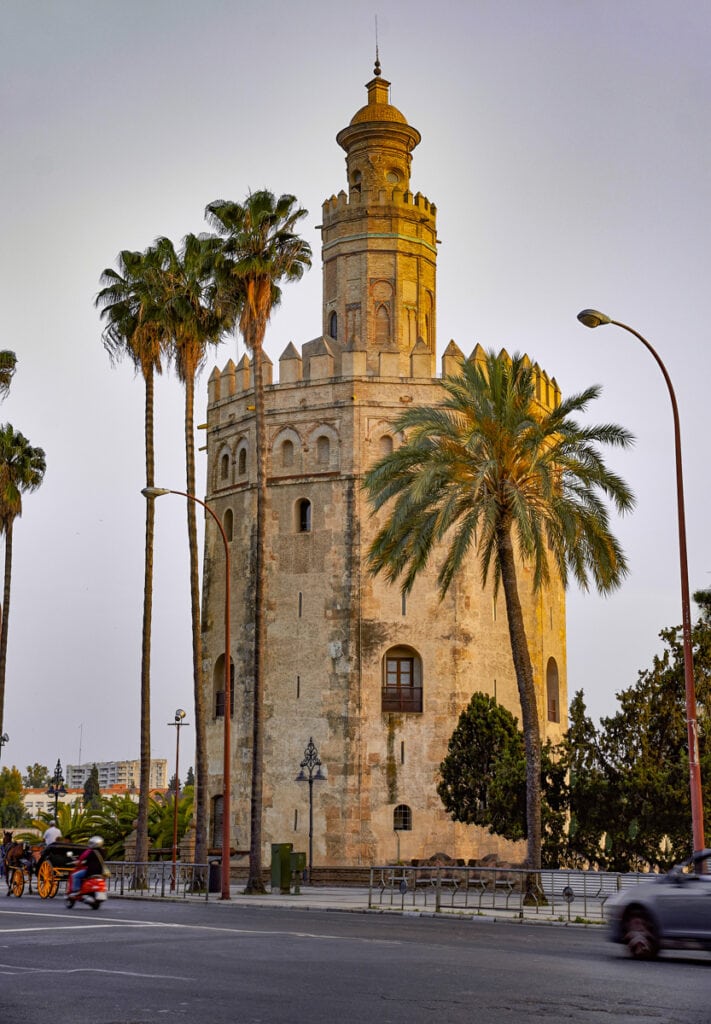
We visited Seville for 3.5 days on our first trip to Andalusia, and did the Hop On, Hop Off bus tour all the way through at the start of our visit.
It provided a great overview of the historic core, allowing us to sit back and enjoy the architecture.
The Hop On, Hop Off bus tour comes with validities of 24 hours or 48 hours. It’s a narrated ride, and you also get a couple of free walking tours and some attraction entry tickets or discounts with your purchase.
5. Wander Seville’s Magnificent Plaza de España
Wandering the enormous Plaza of Spain is one of the best things to do in Seville!
The Plaza de España in Seville is a relatively new structure: it was built in 1928 for the Ibero-American Expo of 1929. It is at the top of their Seville must see list for most visitors to the city.
Located at the edge of the Maria Luisa Park, the impressive square is one of the largest in Spain. Touring the plaza is a must-do in Seville.
The plaza was designed by Aníbal González, a renowned Spanish architect, and is a pleasing blend of many architectural styles, from Renaissance Revival and Baroque Revival to Art Deco and Neo-Mudéjar.
At the back of the plaza is a huge semi-circular complex of buildings, with tall skinny towers grazing the sky at each end. A moat surrounds the plaza, with four bridges allowing access to the building complex from the plaza.
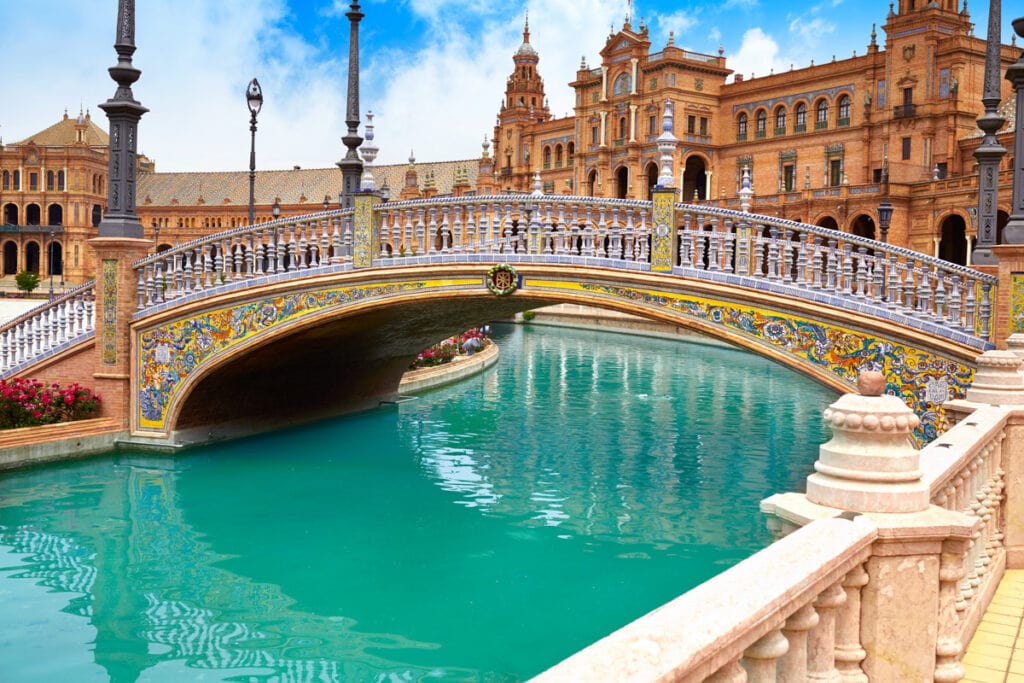
The impressive Vicente Traver fountain occupies pride of place in the plaza, and you’ll definitely want to stop to admire it as you stroll the plaza.
Everywhere you look in the Plaza de España, the tile work will astound you, especially on the sides of the bridges, and the railings.
But the signature tiled feature at the plaza are the alcoves along the bottom of the building complex, one for each province of Spain. Forty-eight provinces are represented.
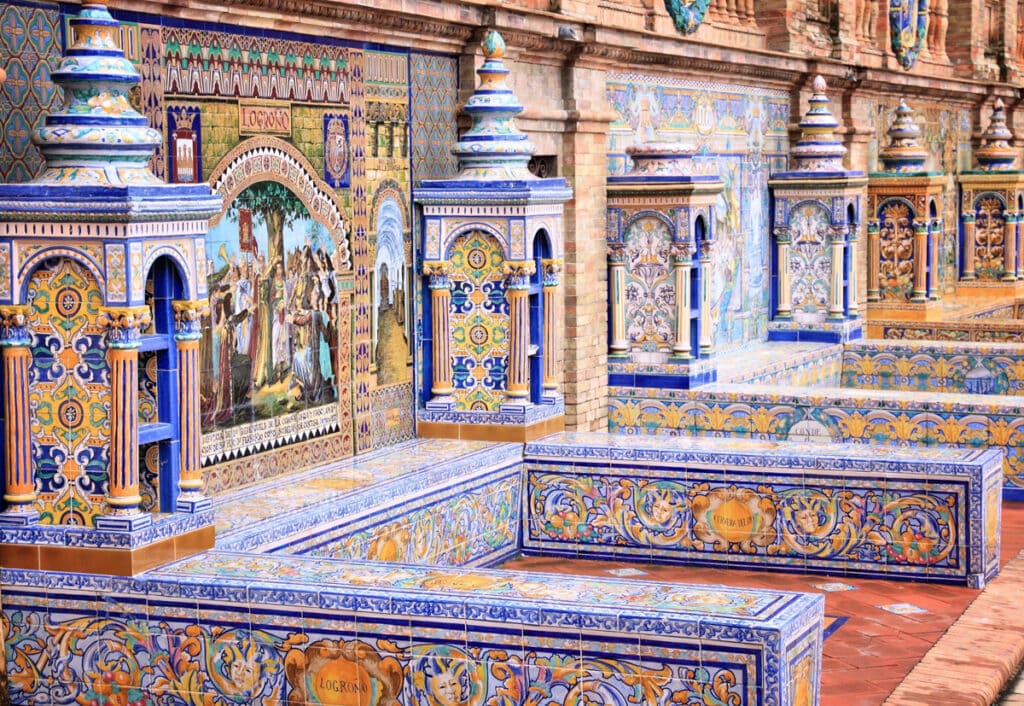
Depicting historical or cultural scenes and/or maps, the colorful alcoves feature intricate tile work.
On a nice weather day, you may want to rent a rowboat and get out onto the water.
Apart from the sights, Seville’s Plaza de España is also a great place for people-watching. Other than early in the day, the plaza is usually very lively, with vendors, tour groups, other visitors, locals, and horse-drawn carriages.
You may even catch a flamenco performance, right on the plaza!
For movie buffs, the plaza featured as a filming location for Lawrence of Arabia and Star Wars: Episode II – Attack of the Clones.
6. Walk the Maria Luisa Park
The Parque de María Luisa is Seville’s most well-known park, and its largest green space, stretching all the way to the Guadalquivir River.
Strolling the beautiful park is one of the best free things to do in Seville.
Other than the Plaza de España, you’ll find many beautiful buildings in various pavilions along the park’s fringes, with gardens and green spaces inside.
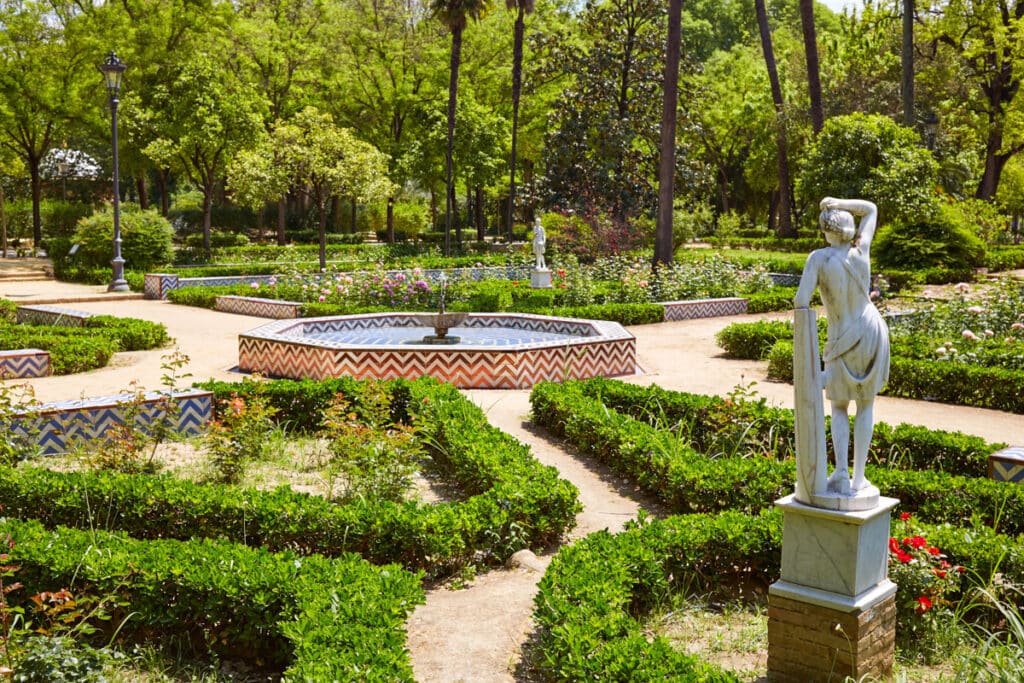
Originally part of the grounds of the San Telmo Palace, the park area was donated to the city towards the end of the 19th century.
The park features beautiful plantings of orange trees, palm trees, pines and other trees, along with botanical specimens from many parts of the world. You’ll also find flower beds for color.
Along with the greenery, the Maria Luisa Park also features beautiful tiled fountains, ponds, and monuments. Don’t miss the Fountain of the Lions, the tiled Fountain of the Frogs, and the Estanque de los Lotos, a pool with water lilies.
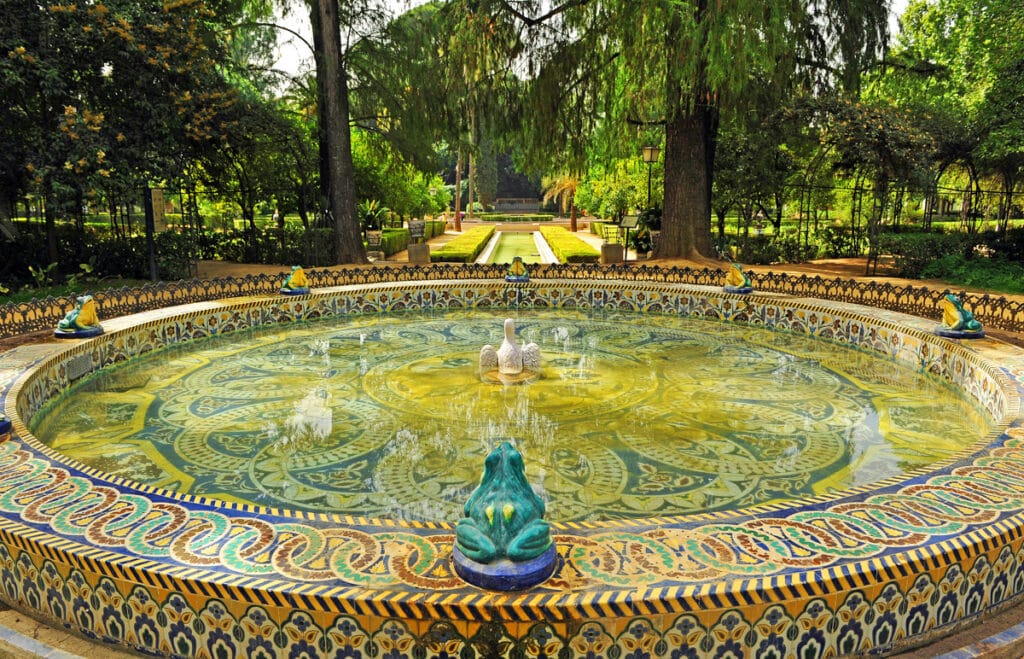
You’ll see (and hear!) lots of birds in the park. Look for parakeets that live in the gardens, and ducks, swans and other types of birds.
Some of the beautiful buildings around the periphery are now museums. Even if you are not a big fan of museums, it’s worth strolling over to admire the architecture.
A bike tour is a great way to get an overview of Seville’s historic center. This highly-rated and very popular 3-hour tour takes you to many of Seville’s most iconic sights, and you will be enthralled by the informative commentary.
7. Eat Your Fill of Tasty Tapas!
With 3,000+ tapas bars and a wealth of restaurants, Seville offers an overwhelming choice of places to eat. And eating your way through as many bars as you can is one of the most enjoyable activities in Seville!
There is a big variety of dishes to sample, from salmorejo (a cold tomato soup) to berenjenas con miel (fried eggplant sticks drizzled with honey) and cheeses like manchego to jamón.
Cumin flavored spinach with chickpeas, stewed pork cheeks, solomillo al whiskey with garlic and lemon, and melt-in-the-mouth oxtail stew are other tapas to try in Seville, especially in cooler weather.
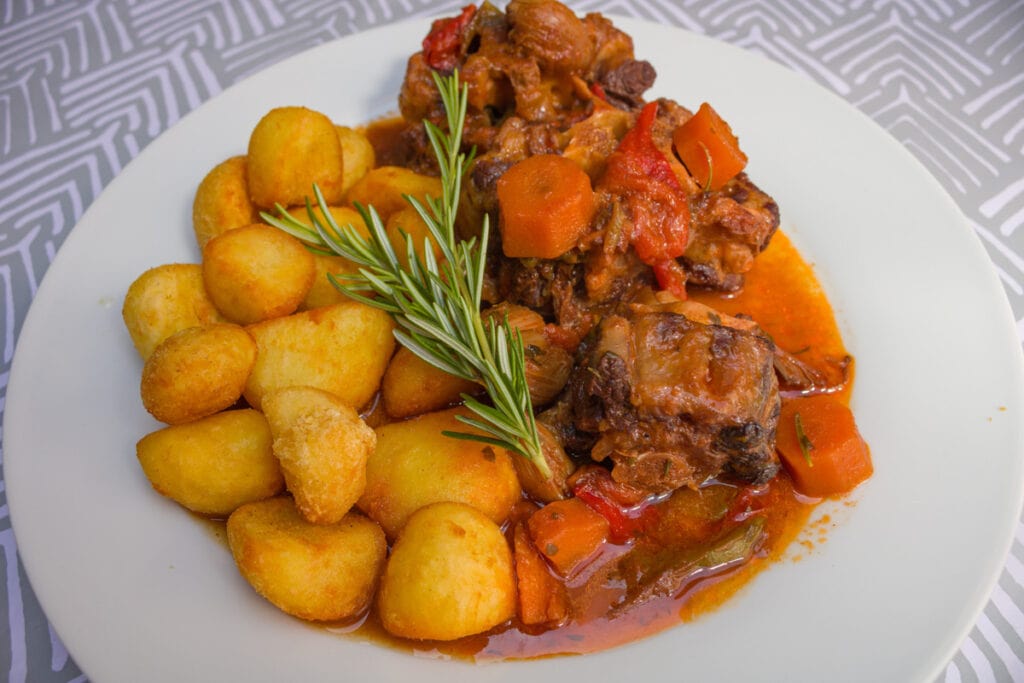
On our visits to Seville, we rarely have regular lunch or dinner. With so much tasty tapas waiting to be sampled, why limit yourself to just one starter or main dish?
A food tour is a great way to sample a variety of tapas with a local guide, who will also offer recommendations for other tapas bars to visit during your stay in the city.
This highly-rated tapas crawl includes about a dozen samples of tapas, 4-5 drinks, and dessert. The 3-hour evening tour takes you to five local bodegas while your guide offers commentary on the city’s cuisine and how it has been influenced by its history and culture.
Our favorite tapas bars in Seville include El Rinconcillo, Seville’s oldest bar that has been serving up traditional Andalusian favorites since 1670! You can book on their website online.
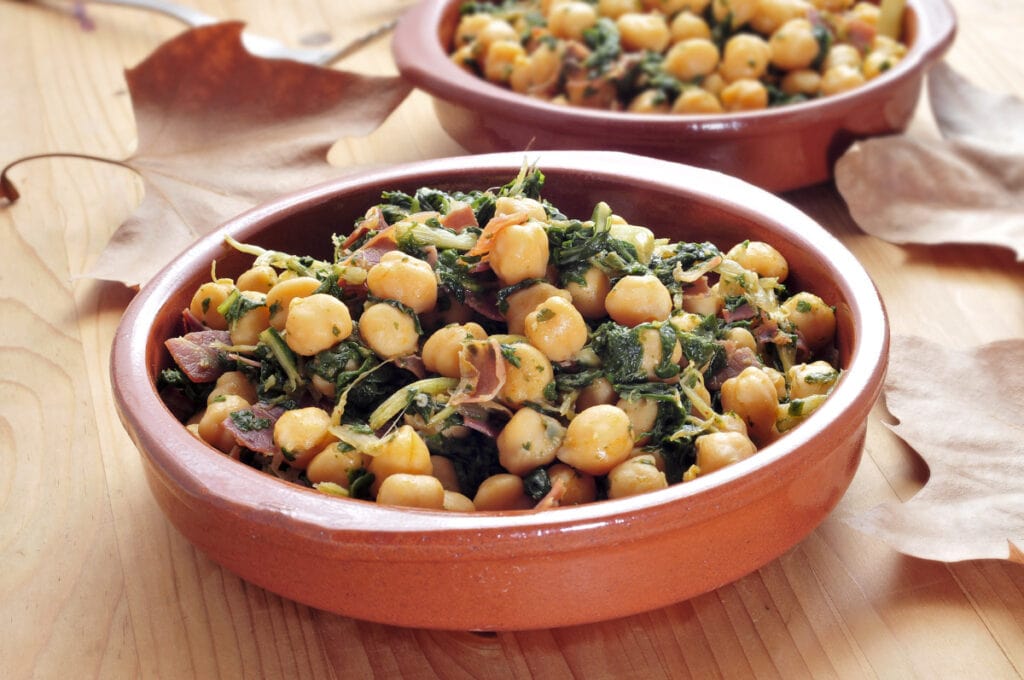
Eslava is another extremely popular tapas bar in Seville. They are famous for their egg yolk on boletus cake, but everything we tried here was delicious, desserts included. Be sure to book online.
We also love La Azotea. They have several locations in Seville: we’ve eaten more than once at the Jesus del Gran Poder location. Their tapas is considered innovative, with ingredients like kimchi. The flavors will explode in your mouth!
Want to get in on the action and take a Spanish cooking class while you’re in Seville?
This popular 3-hour cooking class is held inside the Mercado de Triana, using fresh-bought ingredients. Enjoy sangria and olives as you cook, and dine on the dishes you prepare!
8. Enjoy a Flamenco Show
Attending a flamenco show is high on the bucket-list for many visitors to Seville.
It’s energetic, it’s exciting, and it’s VERY enjoyable.
A performing art form believed to have originated right here in Southern Spain, flamenco involves not just dance but also poetry, music, rhythmic hand clapping, and finger snapping.
Add in the flamboyant costumes and the electric ambience, and a good flamenco performance will stay in your memory for a long time.
You can take in a flamenco performance in a dinner or drinks setting, or you can attend a dedicated performance in a theater.
One of the best places in Seville to enjoy a topnotch flamenco show is the Flamenco Museum, where the setting is a small historic courtyard.
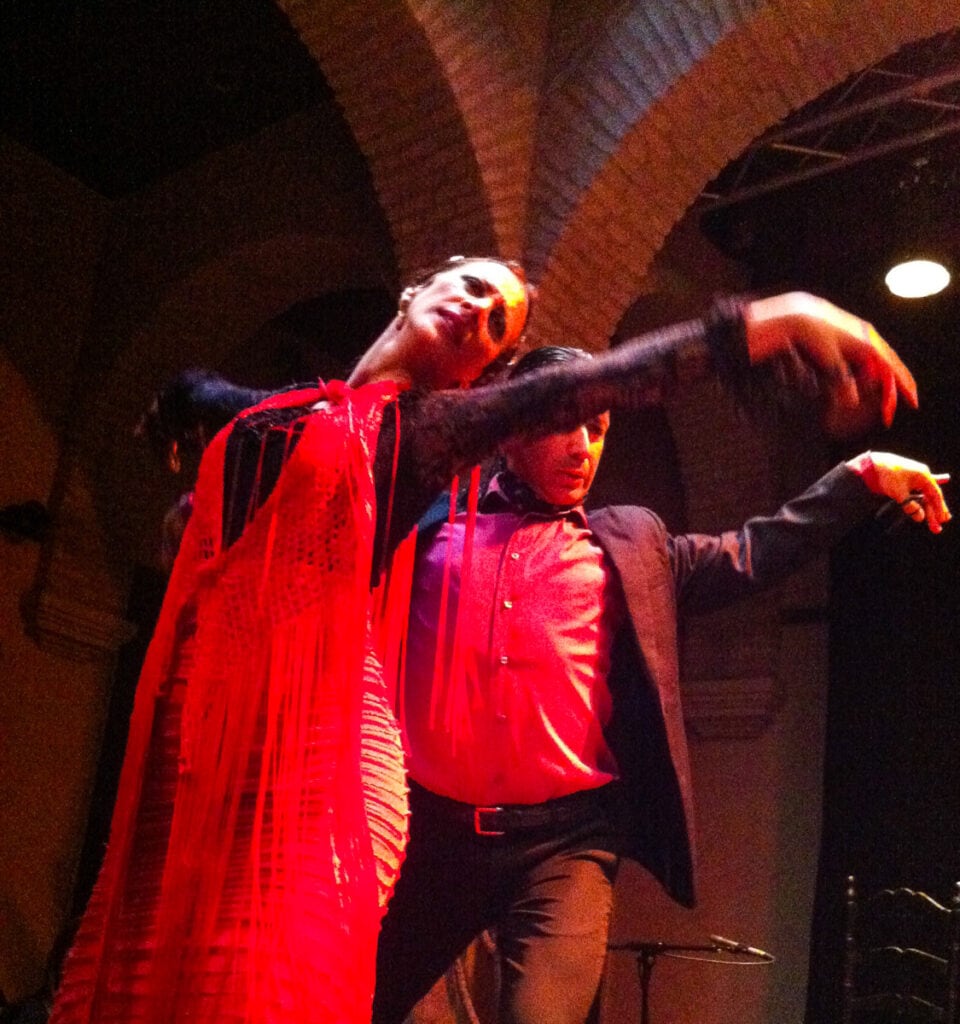
If you arrive early and get seats in front, you can see the expressions on the performers’ faces, and their feet as they perform intricate footwork!
Another esteemed venue is the larger Teatro Flamenco Sevilla, where you’ll find theater-style seating and excellent lighting for great views of the stage. Their one-hour show features six quality performers.
The Casa de la Memoria is a more intimate setting in the historic quarter, and the Tablao Flamenco el Arenal combines a drink and a show in a setting that dates back to the 17th century.
Across the river in Triana, you’ll find the Teatro Flamenco Triana, with a capacity of about 125 people. The venue is owned by a flamenco school, so you may see both established performers and the cream of up-and-coming talent.
The Baraka Sala Flamenca Triana is a popular drink-and-show setting in an atmospheric cellar in the Triana neighborhood.
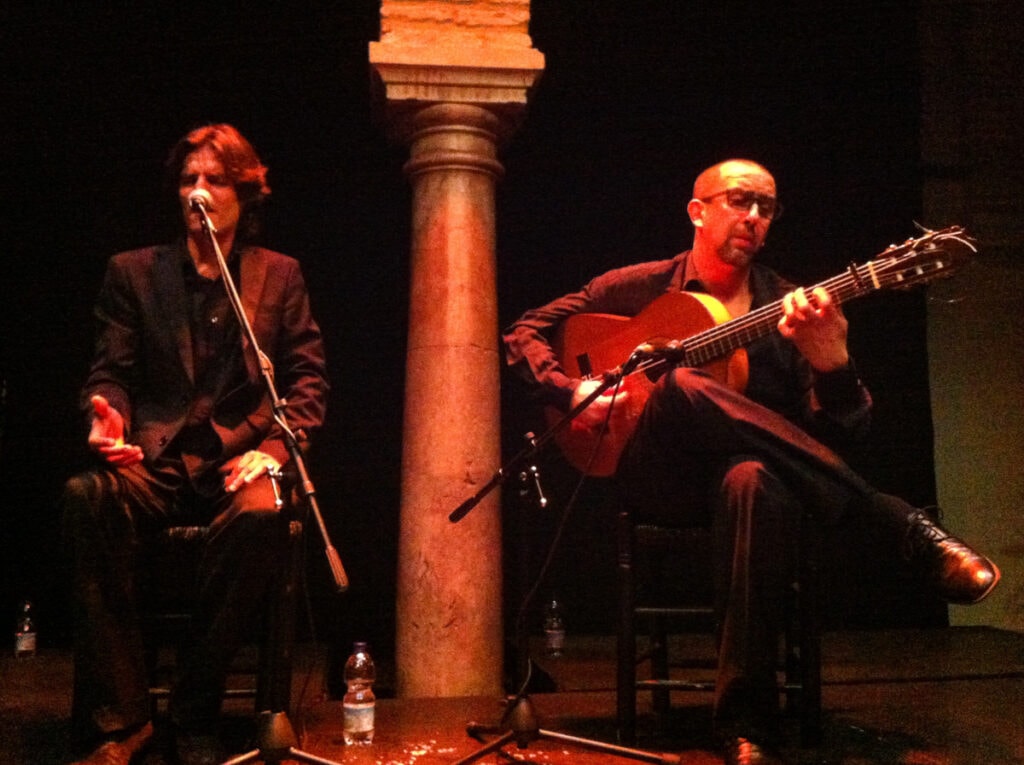
Want to take a flamenco lesson while you’re in Seville? This well-reviewed one-hour small group class for beginners is held in a local flamenco studio. With just 2 to 8 participants, the class is fun for both men and women!
9. Stroll Barrio Santa Cruz
Along with the Triana neighborhood across the river, Barrio Santa Cruz is a neighborhood you’ll definitely want to stroll when you visit Seville.
The touristic center of Seville, the neighborhood used to be the city’s former Jewish Quarter: when Ferdinand III of Castile conquered Seville, he confined the Jews in the city to the Barrio Santa Cruz.
When the Jews were banished from Spain in 1492, the quarter deteriorated until the 18th century, when it was revitalized as a neighborhood.
Today, the charming quarter is a joy to wander aimlessly, although it can be congested in season. Even when it’s crowded though, a wander through the quarter is one of the most fun things to do in Seville.
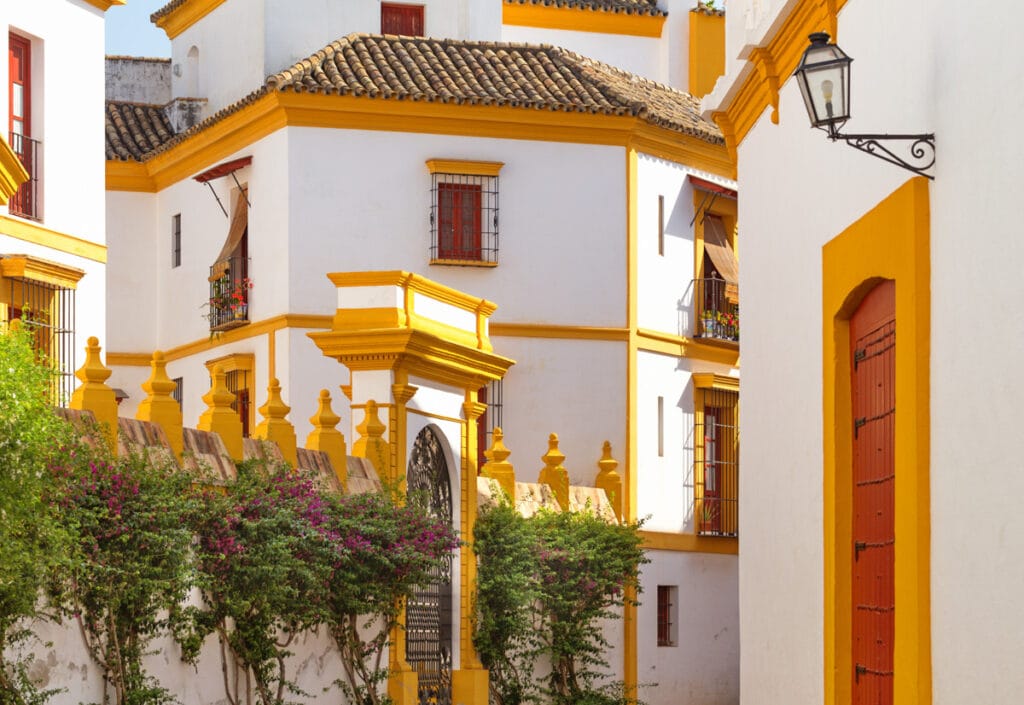
The labyrinthine cobblestone alleys are impossibly narrow, sometimes lined with the orange trees you’ll find everywhere in Seville.
Whitewashed houses feature distinctive golden-yellow highlights. Here and there a wall in yellow or red adds just the right pop of color.
The plazas are picturesque, often with a fountain, lots of trees, and benches to sit and do some people-watching.
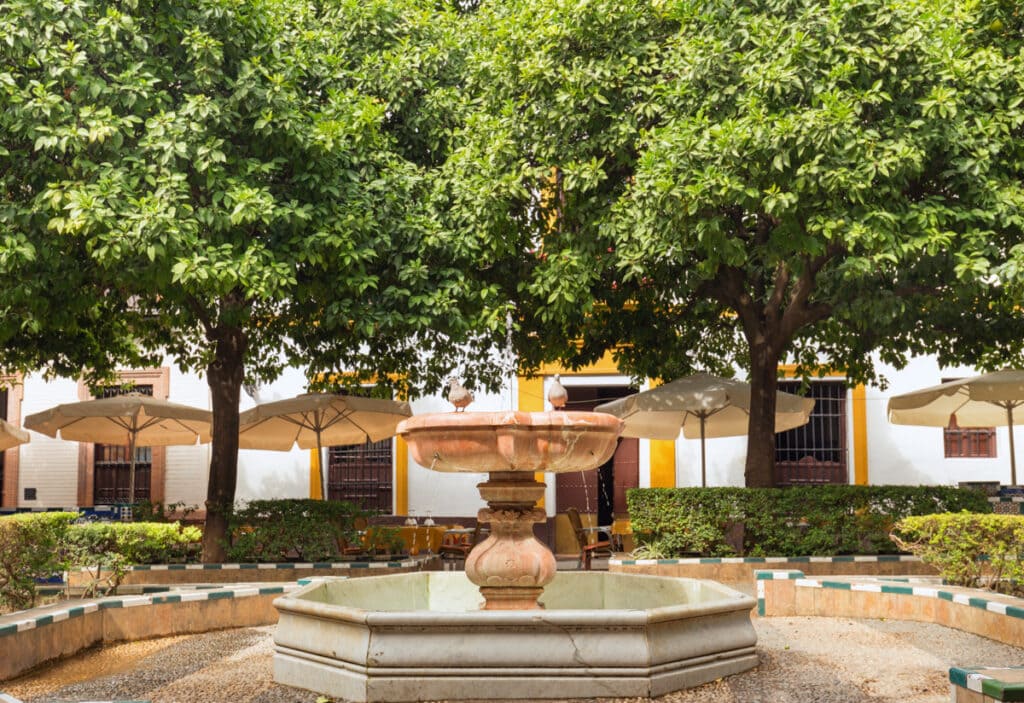
The barrio is home to a huge number of restaurants and tapas bars, so Santa Cruz is also a great place to dine in Seville. But do your research, because sadly, some of the eateries here are tourist traps.
Pro tip: If you plan to be in Seville for a few days, we suggest walking Barrio Santa Cruz early in the day at least once. It’s the most peaceful time of the day in the normally frenetic quarter, and you can snap photos without lots of people in them.
10. Take in the Views from Las Setas de Sevilla
Las Setas, or the Mushrooms of Seville, is an undeniably modern structure in Seville’s historic quarter, but one of the Seville attractions you won’t want to miss.
Also called the Metropol Parasol, Las Setas consists of six huge wooden mushrooms, woven together. It’s a must-see, more modern attraction in historic Seville!
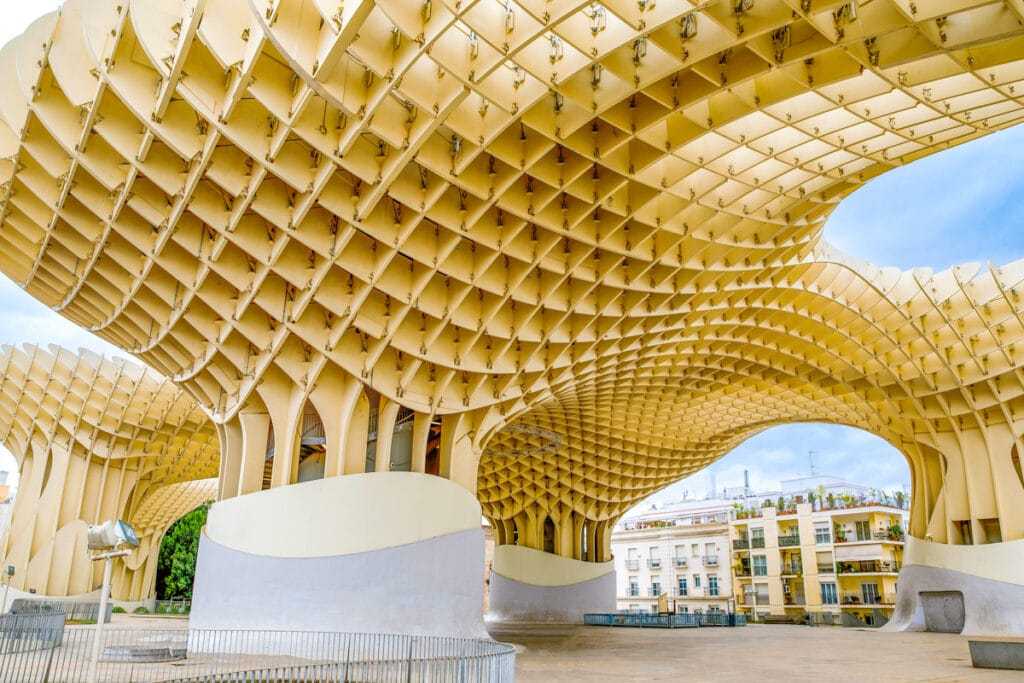
Las Setas was designed by German architect Jürgen Mayer, who won a competition calling for designs to rejuvenate the Plaza de la Encarnación.
Mayer’s design is said to be inspired by the vaults of the Seville Cathedral and the ficus trees in the nearby Plaza del Cristo de Burgos.
Completed in 2011, the complex is organized over several levels.
At the very bottom is the Antiquarium, which houses Roman and Moorish artifacts uncovered at the site.
On top of that is the Central Market, at street level. The roof of the market is an open-air plaza, used for events.
The level above the plaza holds a tapas restaurant and other event spaces.
At the very top is a pathway you can walk, for views of the city center. There are signs that describe what you can see from various points along the pathway.
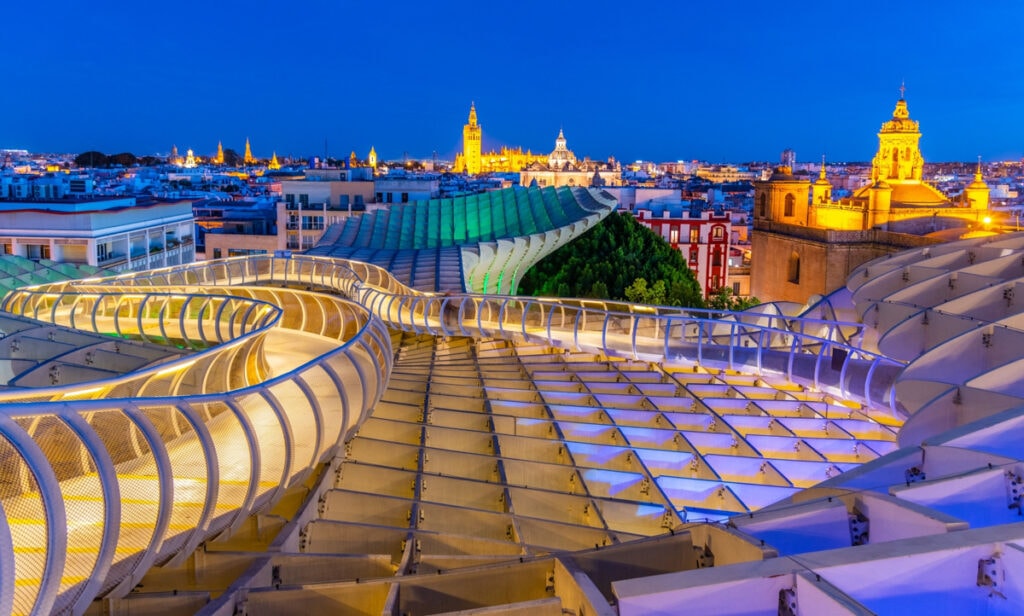
The viewing platform offers 360-degree panoramas of Seville, so you’ll want to snap lots of photos!
With general all-inclusive admission, you can also enjoy Feeling Seville, a multi-sensory experience, and Aurora, a light show that happens after dark.
Sunset is a particularly nice time to visit. Walk the pathway, and watch the lights of the city come on after the sun sets, and stay until after dark to see the light show!
Tip: In season, buy skip-the-line tickets ahead of your visit, or join a guided tour that includes skip-the-line admission.
11. Walk Across the River to Triana
Across the Guadalquivir River is Triana, a colorful and historic neighborhood where the residents are immensely proud of their local identity.
While many visitors to Seville are content with snapping photos of the colorful waterfront facades across the Guadalquivir, those that cross over to the other side are rewarded with some memorable experiences.
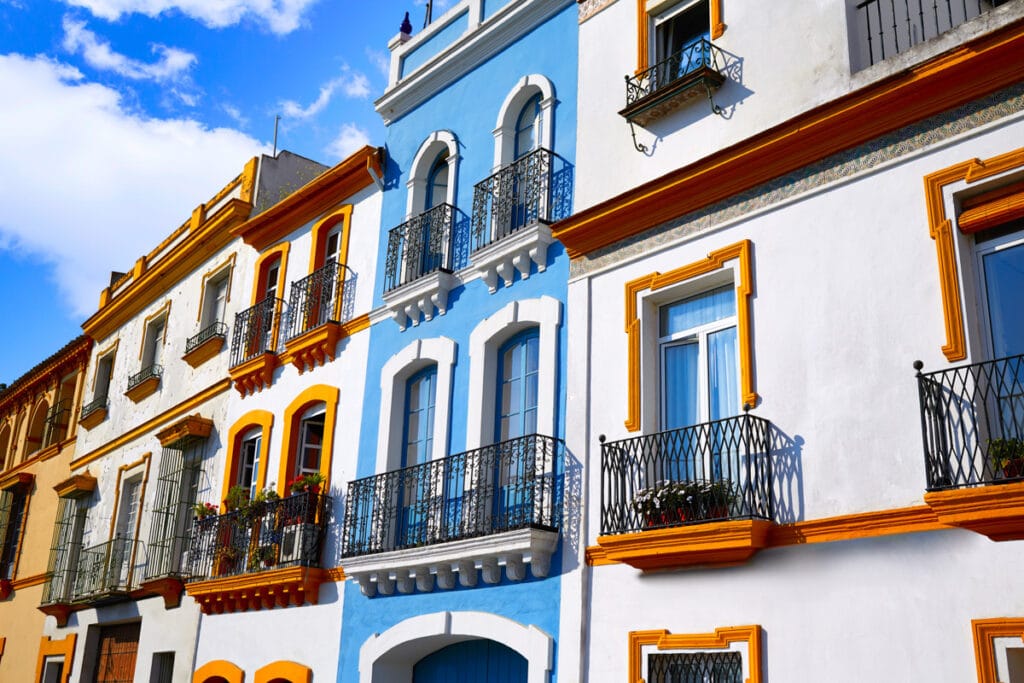
Puente Isabel II, completed in 1852, is the bridge you’ll cross to get to Triana. As you walk across, you can snap photos of the picturesque waterfronts on both sides!
Just off the bridge is the Capilla del Carmen, a small chapel with a tower and a colorful dome, designed by Anibal Gonzalez in the Moorish Revival style.
Nearby you’ll find the Mercado di Triana, also built in the Moorish Revival style. The market offers fresh produce, fruit, and other foods like olives, cheeses and jamón.
The chapel and market are built at the site of the ruins of the Castillo San Jorge, the former headquarters of the infamous Spanish Inquisition. There’s a museum next door if you want to learn more.
Triana has some lovely churches to admire. The Iglesia de Santa Ana is a blend of Gothic and Mudejar and houses an impressive altarpiece. The Sailors’ Chapel is home to the Esperanza de Triana, and has a stunning rendition of the Virgin.
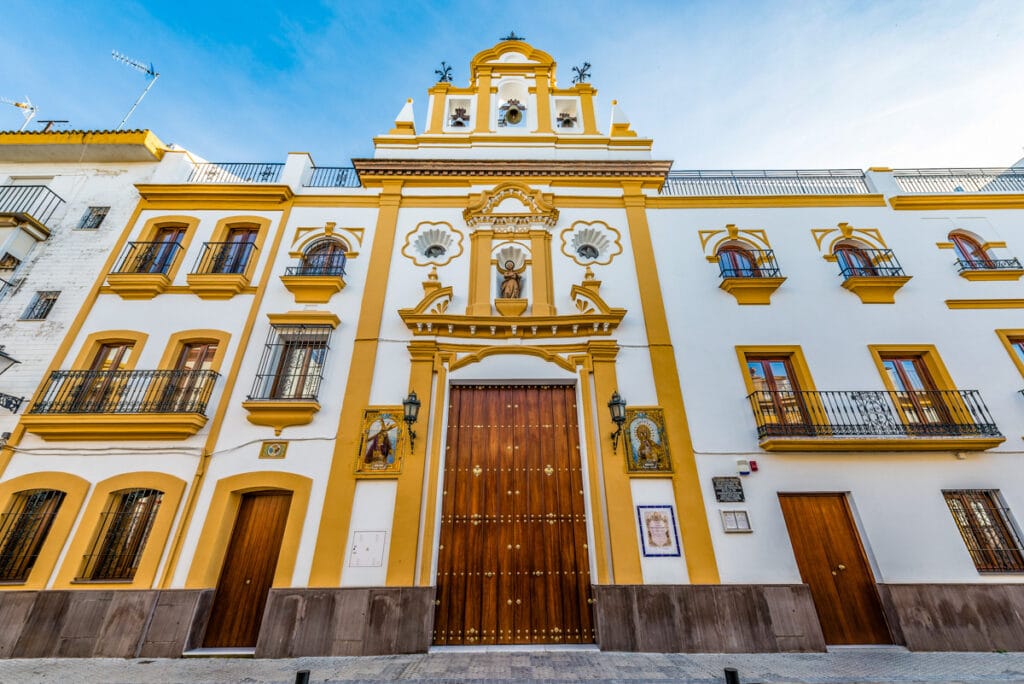
If you want to bring home ceramics as souvenirs from Seville, Triana is one of the best places to shop! Ceramica Triana and Ceramica Santa Ana are two popular shops. There’s a small ceramics museum if you want to learn more.
Stroll the Calle Betis on your way back. The waterfront street boasts beautiful facades and offers views of the river and the city center.
12. Tour the Roman Ruins at Italica
Located in Santiponce, just a short distance from the city center of Seville, are the Roman ruins of Italica.
For art, history, and architecture enthusiasts, an excursion to the site makes for a worthwhile full-day or part-day trip from Seville!
The ruins lie below current-day Santiponce, and excavations are ongoing. But what has been done so far reveal a remarkably well-preserved Roman city, with cobblestoned streets and many in situ mosaics.
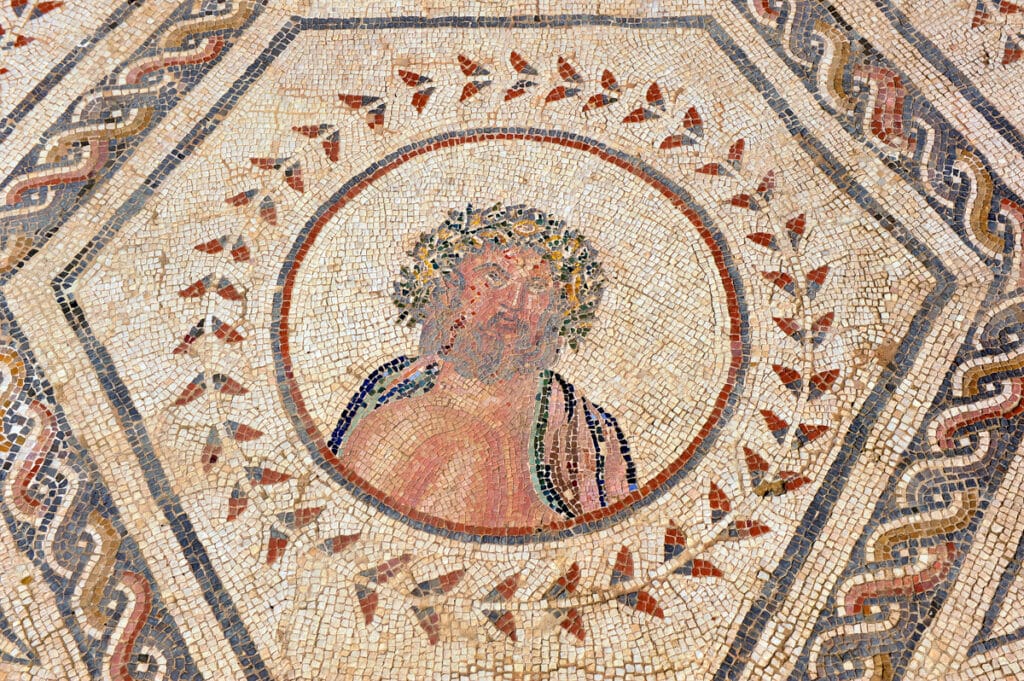
Italica was the first Roman settlement in Spain, and one of the first outside Italy.
Founded in 206 B.C. by the Roman general Scipio, Italica is known for being the birthplace of the Roman emperors Trajan and Hadrian.
Hadrian in particular is credited with expanding the city of Italica and building many fine structures here, and it flourished under his rule.
By the third century, Italica’s position diminished because of a shift in the course of the Guadalquivir River, while Hispalis (now Seville) continued to thrive.
Sadly, the ruins of Italica continued to be plundered for building materials well into the 18th century, and it wasn’t until decades later that Italica was definitively protected.
Today, you can wander the excavated ruins and admire the remains of this once magnificent Roman city.
The amphitheatre is the largest structure still partially standing: it was the third-largest arena in the empire at the time.
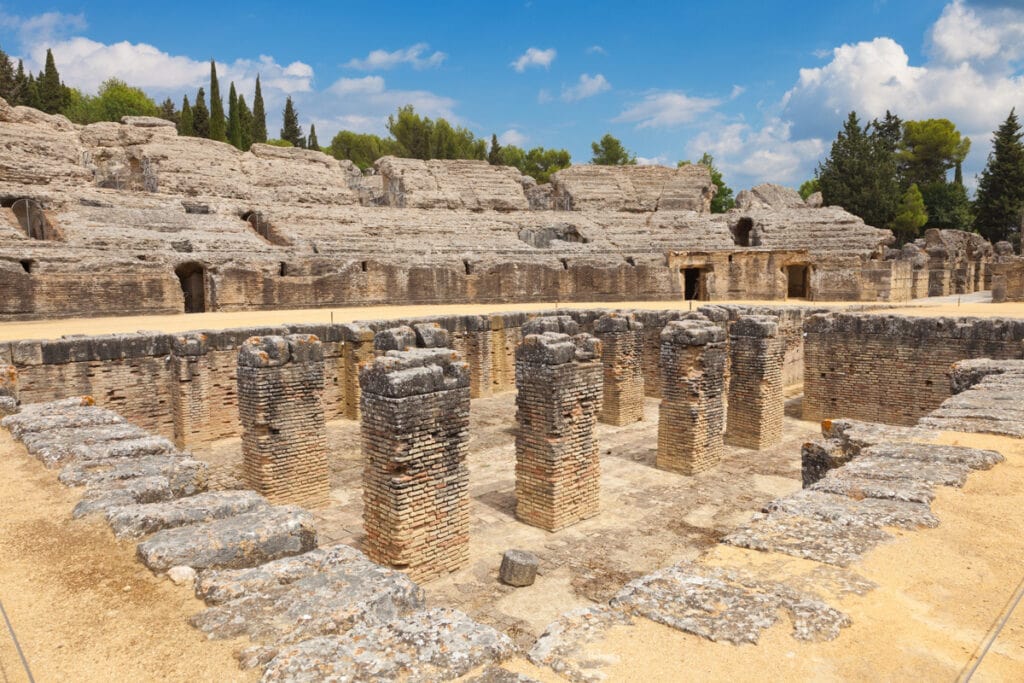
Also view the remains of the Traianeum, an impressive temple built by Hadrian in honor of Trajan, his father.
Arguably the coolest sights in Italica are the mosaic floors from some of the villas and houses built in Roman times. Look for some of these mosaics in the House of the Exedra, the House of the Birds, and the House of the Planetarium.
To visit Italica on your own, you can take a bus from the station at the Plaza de Armas. The bus takes just 15 minutes each way.
Or, you can take this highly-rated half-day guided tour to Italica from Seville, and visit with a local guide who will narrate the history and context of what you see as you wander.
13. Discover the Las Duenas Palace
Seville boasts a number of smaller palaces that are beautiful and have a more intimate setting than the Royal Alcazar. If your itinerary allows, the Las Duenas Palace makes for a serene and relaxed visit.
The Palacio de las Dueñas boasts a rich history and has changed hands a number of times since it was built. Antonio Machado, one of Spain’s most famous poets, was born here.
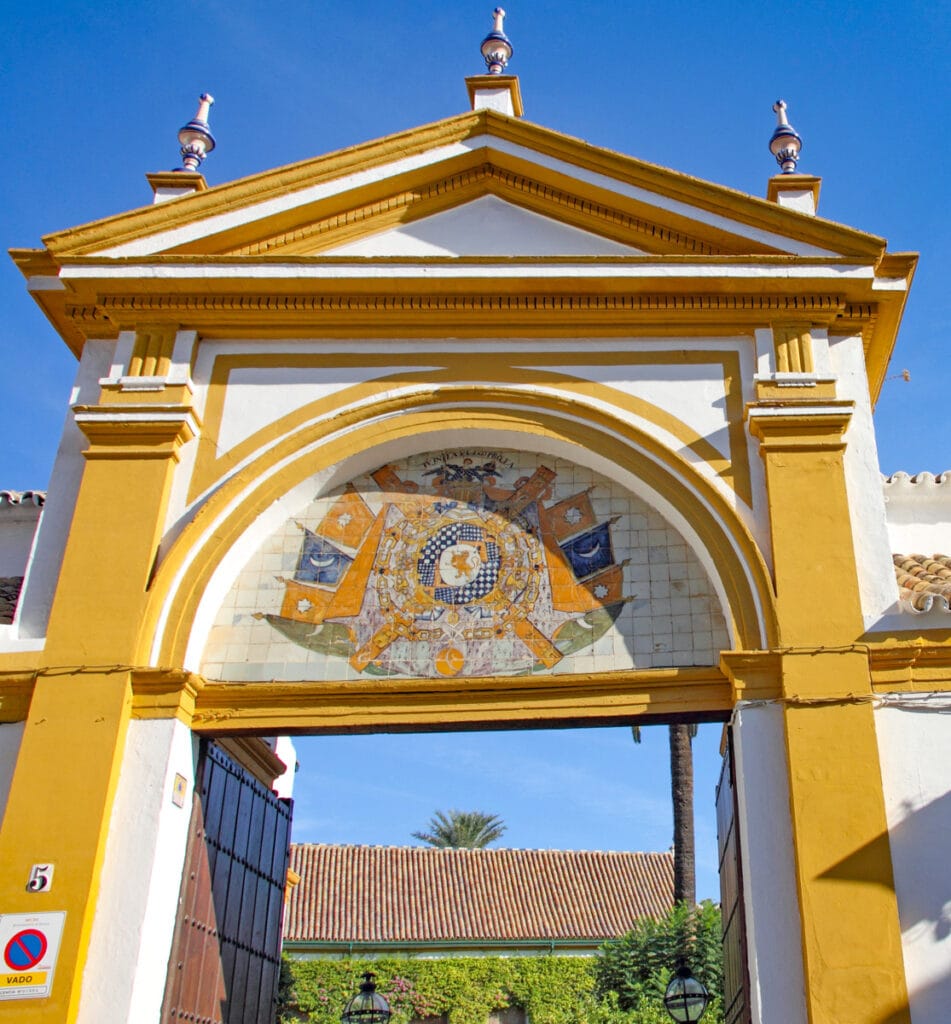
Built between the 15th and 16th centuries, the Las Duenas Palace is currently owned by the House of Alba. The palace is built in the Renaissance style, with Gothic and Mudejar elements.
It gets its name from the monastery of Santa María de las Dueñas, which was located close to the palace and demolished in 1868.
The Palacio de las Dueñas features a stunning central courtyard that looks out onto the gardens, with the main palace built on the three remaining sides. In the courtyard, you’ll find the columns and lacy arches typical of the Mudejar architectural style.
Also of special note is the main staircase, with gorgeous Flemish tapestries and a beautiful coffered wood ceiling.
The palace is known for its art collection, which includes many paintings by famous Spanish and Italian artists, mosaics, sculptures, ceramics, and antique furniture.
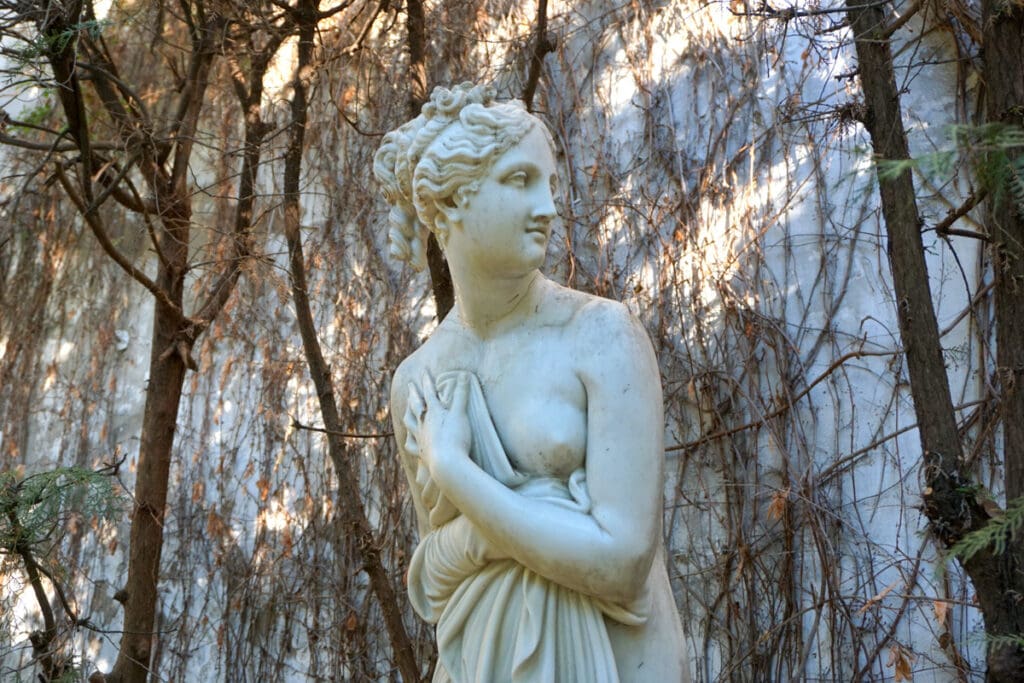
The complex also includes other courtyards and buildings. The gardens feature a dramatic bougainvillea, trained formally over an entire wall of the palace, orange and lemon trees, and many rare and unusual plants.
Buy your tickets and audio guide for the Las Duenas Palace today!
14. Admire the Casa de Pilatos
Casa de Pilatos is the quintessential Andalusian palace and one of the places to see in Seville that you’ll want to consider for your itinerary, especially if you plan to spend more than one day in Seville.
Dating back to the 15th and 16th centuries, Casa de Pilatos is the permanent residence of the Dukes of Medinaceli.
The palace, and its courtyards and gardens, are a blend of architectural styles, including Gothic, Mudéjar, and Plateresque. The complex is particularly notable for the extravagant use of azulejos.
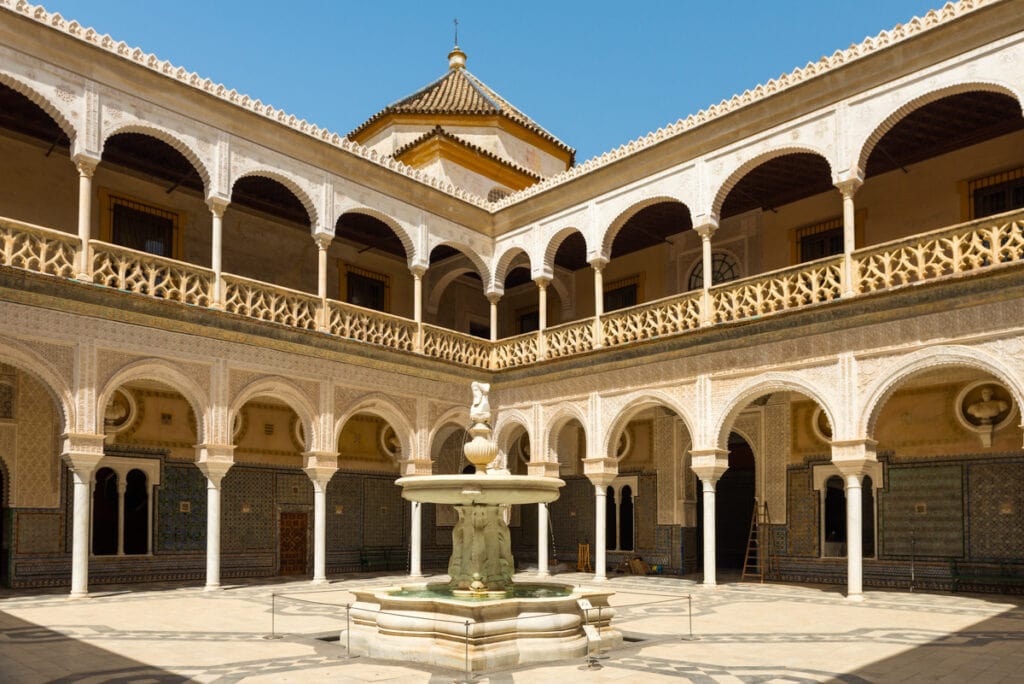
The beautiful tile work, combined with intricate Mudéjar architectural elements, make the Casa de Pilatos well worthy of your time.
Look for the many busts of Spanish and Roman royals and nobleman, placed along the courtyards. Many of these busts are from the Roman ruins of Italica.
The staircase that leads from the bottom to the upper floor is beautifully tiled and has a ceiling with the Mudéjar honeycomb design. We thought the staircase was gorgeous.
On the upper floor of the palace, you’ll find more exhibits to admire, including some notable paintings. Look for the intriguing Bearded Woman by Jusepe Ribera!
The gardens contain a truly stunning bougainvillea, draped over a wall. In full bloom, it will stop you in your tracks! They also include several sculptures, boxed flower beds, formally shaped orange trees, and water features.
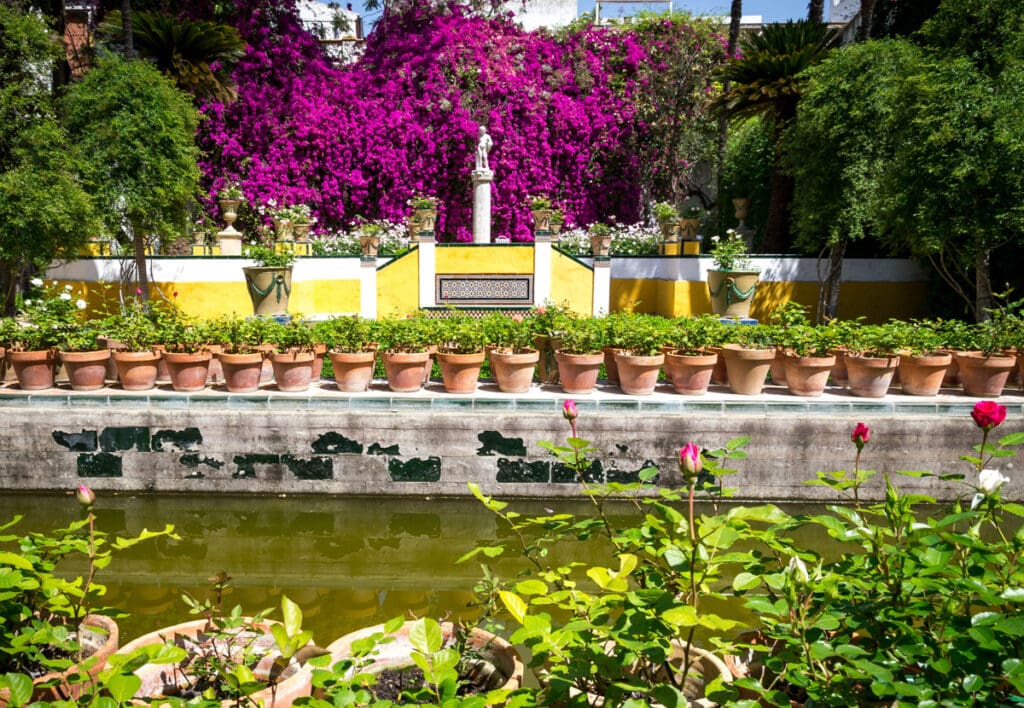
There are many benches that invite you to sit down for a few minutes and enjoy your surroundings in the warmth of the Spanish sun.
Casa de Pilatos has served as a filming location for several movies, including Lawrence of Arabia and Knight and Day.
15. Visit the Museo Palacio de la Condesa de Lebrija
Among the many palaces in Seville, the Museo Palacio de la Condesa de Lebrija is worth visiting for its astonishing collection of well-preserved Roman mosaics from the ruins of Italica.
Originally built in the 15th century, the palace was renovated more than once thereafter.
It was eventually bought in 1901 by the Countess of Lebrija, who restored it over a period of several years. A traveler and passionate collector, the Countess filled the palace with an eclectic collection of art objects she acquired.
The restored palace features not only the gorgeous Roman mosaics, but also a lot of tile work and Mudejar architecture. Mosaics not only line many floors, they are also displayed on the walls.
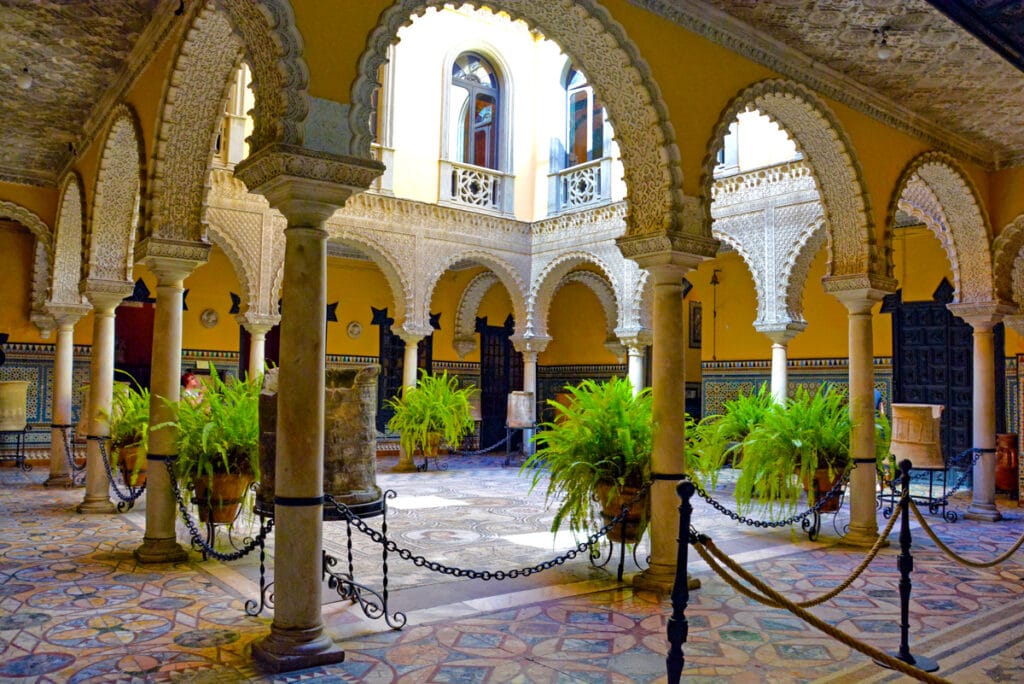
The mosaic of Pan serenading Galatea on his flute in the central courtyard is particularly breathtaking!
The tile work in the palace is beautiful, especially on the staircase and surrounding walls. You’ll also find paintings, bits of columns, amphoras and urns, and sculptures.
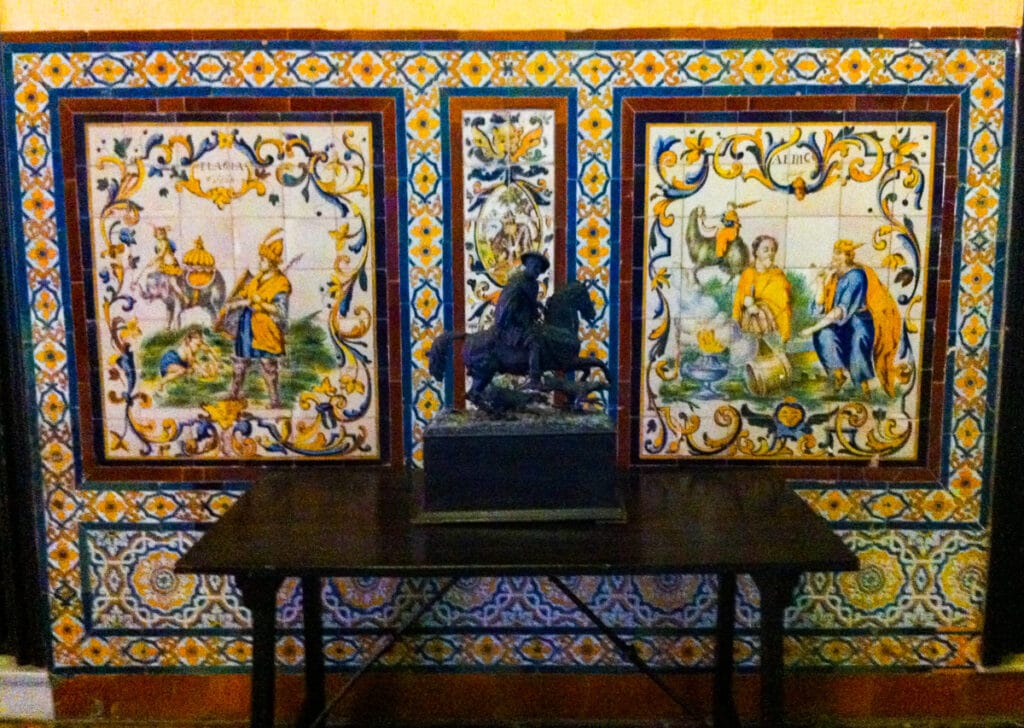
The upper floor of the palace is kept as the family had it when they lived here, and each room contains many art objects and paintings to admire.
Pro tip: The upper floor of the palace can only be accessed on a guided tour, so try to time your visit for one of these tours. They are usually held through the day.
16. Admire the Art at the Museo De Bellas Artes De Sevilla
If you enjoy art, be sure to put the Seville Museum of Fine Arts on your list of places to visit in Seville.
The permanent exhibits are impressive, and sometimes there are temporary exhibitions as well. Spread over two floors, the collection is not so large that it is overwhelming.
And as a bonus, the setting of the museum, in a historic monastery building, is beautiful as well. The main courtyard is gorgeous!
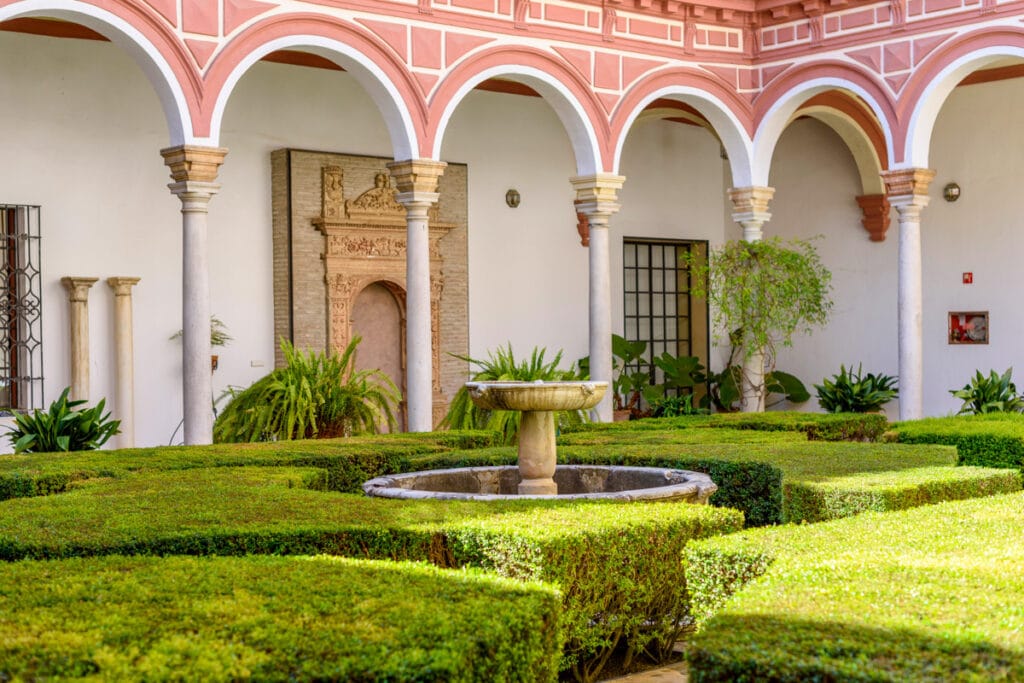
In the Plaza del Museo, where the museum is located, you’ll find a bronze statue of Bartolomé Esteban Murillo, one of Spain’s most famous artists.
The Seville Museum of Fine Arts opened all the way back in 1839 in this same building, which was built in 1594 and renovated in the Mudéjar style in the 17th century.
The museum is mainly focused on Spanish art, and includes works from the Middle Ages, through the Renaissance and Baroque periods, and up to the early 20th century.
The museum’s collection includes major works from the Golden Age of Sevillian Painting, from the 17th century.
Although most of the paintings are religious, you’ll also find portraits, and some cultural works depicting city scenes, flamenco, and bullfighting.
Look for works by Murillo, El Greco, Francisco da Herrera the Younger, Francisco Zurbarán, Francisco de Goya, and Velásquez.
You’ll also find some works by Picasso, and some from international artists as well.
17. Climb to the Top of the Torre del Oro
One of Seville’s most photographed landmarks, the Torre del Oro sits on the bank of the Guadalquivir River.
The tower’s gorgeous golden facade casts a golden sheen as it reflects in the river, hence its name.
The striking twelve-sided base is from the original tower, built by the Almohads in the 12th century as a military watchtower to monitor access to Seville via the Guadalquivir River.
The next higher level, also twelve-sided, was built in the 14th century by Pedro de Castilla.
And the highest level, circular in shape, was built after the original was damaged in the Lisbon earthquake of 1755.
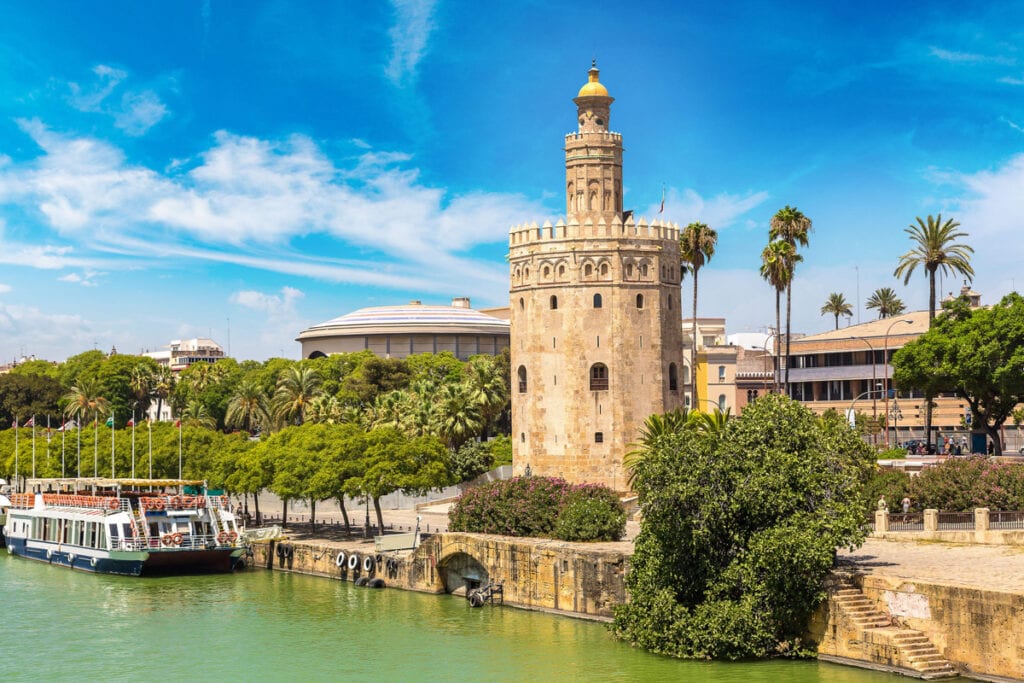
In Almohad times, there was a wall that extended from the Tower of Gold to the next tower in the chain of defense, the Torre de la Plata.
Ships reportedly unloaded their cargoes here when Seville was an important trading port. A part of the tower also served as a prison at one point in its history.
The Tower of Gold is 36m (about 118 feet) tall. You can ascend the ninety-one steps to the top for beautiful views over the river and the city.
The tower also houses a small naval museum, with paintings, documents, nautical charts, instruments, and other artifacts relating to the maritime history of the local area.
The Torre del Oro looks beautiful lit up at night, so if you are out strolling the historical quarter, be sure to stop by to snap some photos!
18. Take a Day Trip to Cordoba
Córdoba is one of the best and most convenient day trips from Seville you can take.
The historic center of Cordoba is a UNESCO World Heritage Site, with a magnificent mosque-cathedral, a Roman bridge, and an Instagram-worthy Jewish quarter.
One of the best things to do in Cordoba is exploring the Mezquita-Catedral, a marvelous blend of Islamic and Christian influences. The interior features a prayer hall with dozens of red-and-white striped horseshoe arches, and an ornate mihrab, a prayer niche.
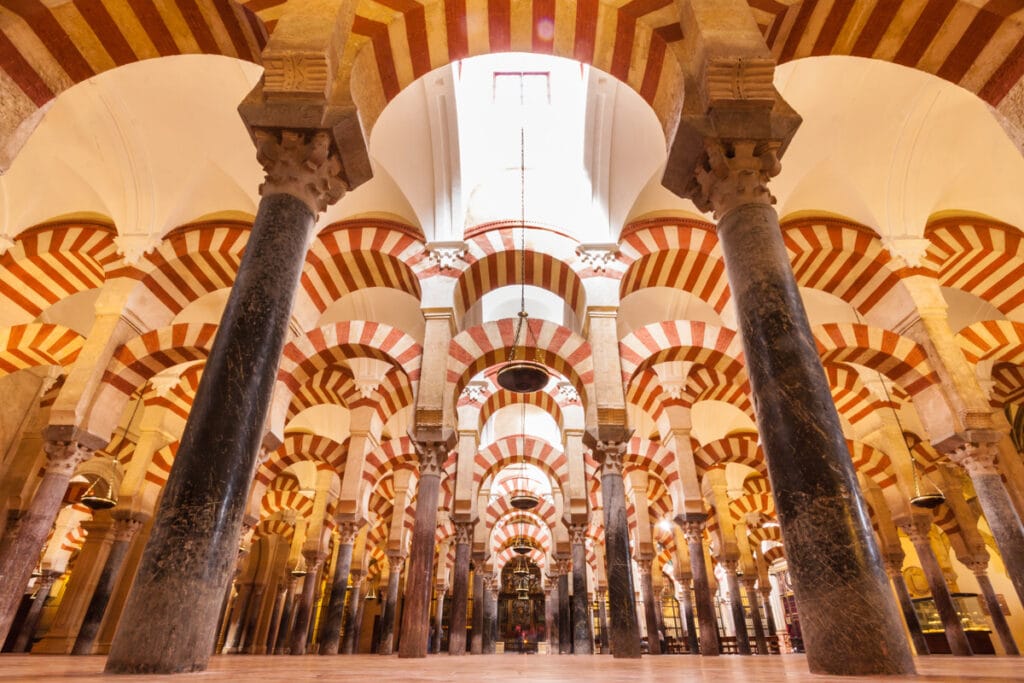
After Cordoba was conquered by the Christians in 1236, the mosque was used as a cathedral but left undisturbed until the 16th century, when the center was replaced by a Capilla Mayor.
Especially in season, skip-the-line tickets for the Mosque-Cathedral are a must. Or invest in a guided tour that includes priority entrance!
The Alcazar de Los Reyes Cristianos is another must-visit landmark on your day trip from Seville to Cordoba. Take in the views from the ramparts of the castle and stroll the beautiful gardens.
Wander the Jewish Quarter of Cordoba, where you will find picturesque narrow alleys, whitewashed houses embellished with flower pots bursting with color, and charming little plazas.
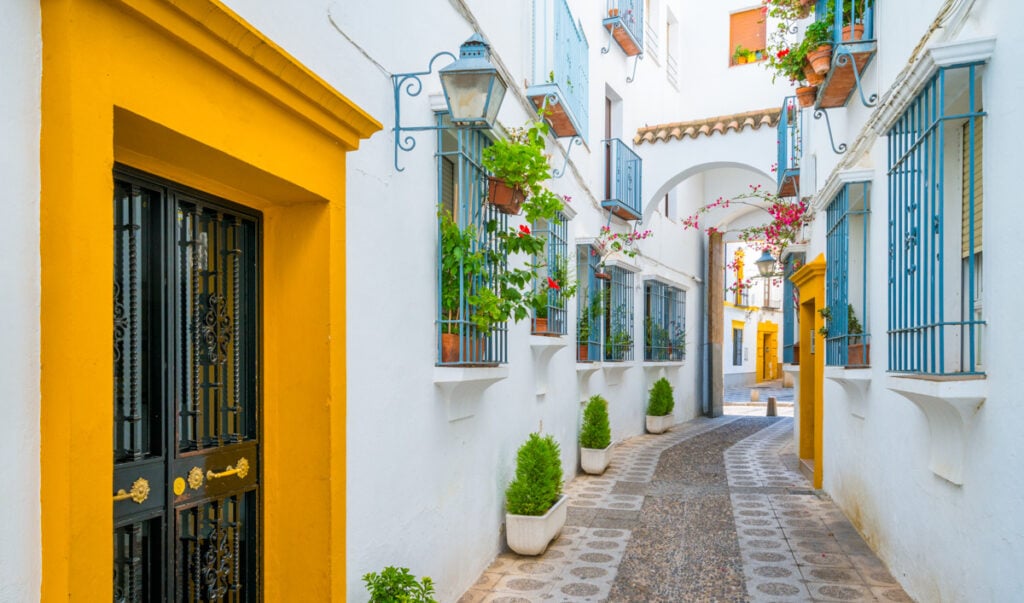
Walk across the Roman Bridge to the Calahorra Tower, which contains a little museum showcasing the region’s history. You can climb to the top for views.
For Game of Thrones fans, the Roman Bridge served as the filming location for the Long Bridge of Volantis.
You can visit Cordoba independently: the high-speed train between Seville and Cordoba takes just about 40 minutes each way.
In Cordoba, this popular combination tour is an efficient way to see the Mezquita, the Alcazar, and the Jewish Quarter! You’ll learn a lot about the history and culture of Cordoba as you explore with a local guide.
Book a guided walking tour of the Mezquita, Alcazar, and the Jewish Quarter of Cordoba now!
Prefer a guided tour from Seville? This well-reviewed tour includes hotel pick-up and drop-off, transport by air-conditioned vehicle, and a guided tour of the Mezquita and the Juderia, with free time to wander on your own.
19. Or Visit Some Pretty Pueblos Blancos!
Andalucia’s white villages are charming, and there are several villages you can visit on quick day trips from Seville.
If you have a car, you can conveniently visit the white villages on your own. If not, book a guided tour so you can see two or three villages on your day trip!
If Ronda is not already on your itinerary, it is a must-visit on a day trip. Perched at the top of the El Tajo Gorge, Ronda offers expansive views of the surrounding countryside.
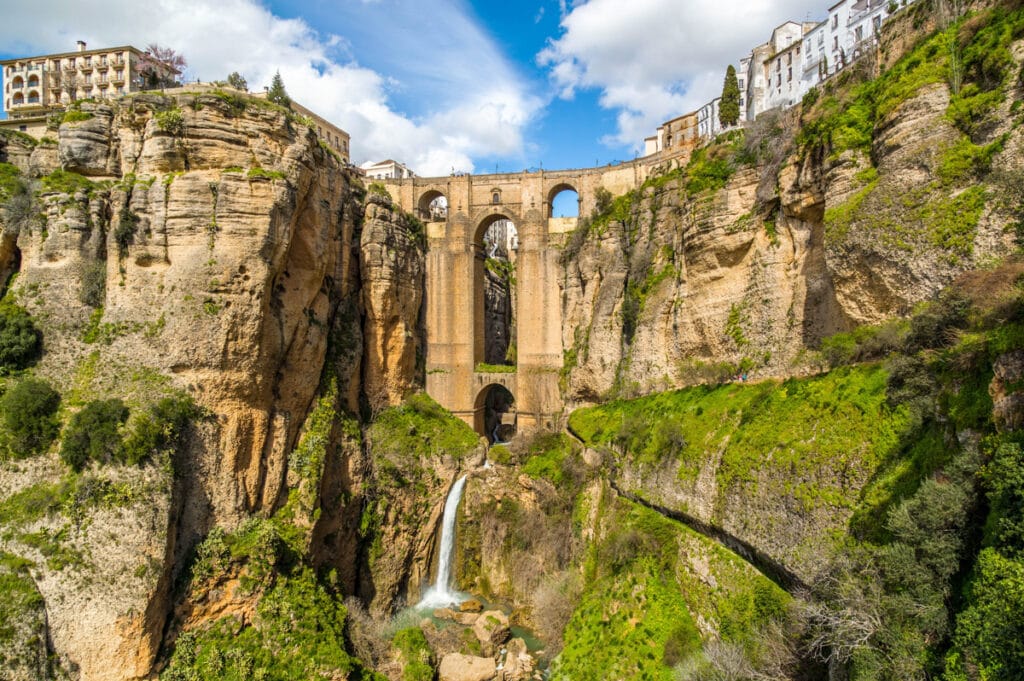
Cross the famous Ronda bridge, the Puente Nuevo, into the old town, where you can stroll the pretty streets, admire the old Arab baths, wander the Cuenca gardens, and visit the Mondragon Palace.
Walking down to the bottom of the gorge for a different perspective on the dramatic Puente Nuevo is another of the top things to do in Ronda!
You can combine a visit to Ronda with other nearby white villages.
Setenil de las Bodegas is just a 20-minute drive from Ronda. It’s a unique white village, because the houses here are literally built into the rock face!
Zahara de la Sierra overlooks a beautiful lake. It features a dramatic Moorish castle, set high upon a hilltop, and the characteristic white houses set close together.
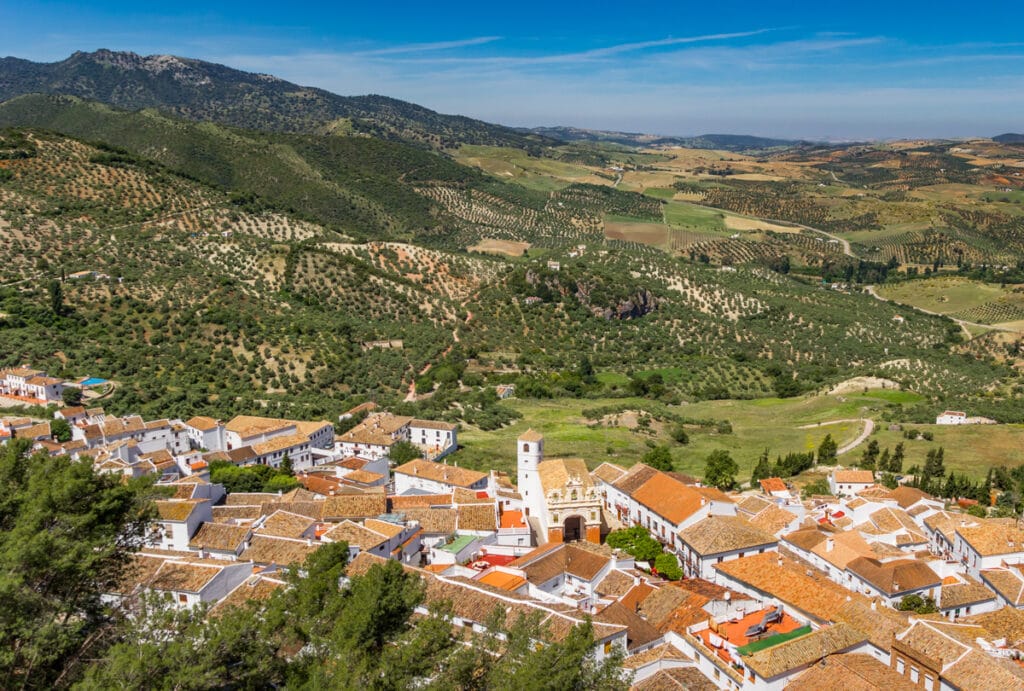
Grazalema, another lovely white village nearby, is set on a high valley, with spectacular surrounding natural scenery. The Sierra de Grazalema Natural Park features rugged limestone peaks and a variety of wildlife and birds.
This extremely popular guided tour takes you to picturesque Ronda, along with stops at Zahara and Grazalema, two of the most charming pueblos blancos in Andalusia.
En route, you’ll also enjoy some of the region’s stunning landscapes.
20. Visit Other Seville Churches
Other than the Seville Cathedral, there are several impressive churches to visit in Seville, for the art and architecture.
The facade of Seville’s “pink” church, Iglesia Colegial del Salvador, is stunning. Second only to the cathedral in size, the ornate Baroque interior features a lot of gold and silver, with decorated chapels.
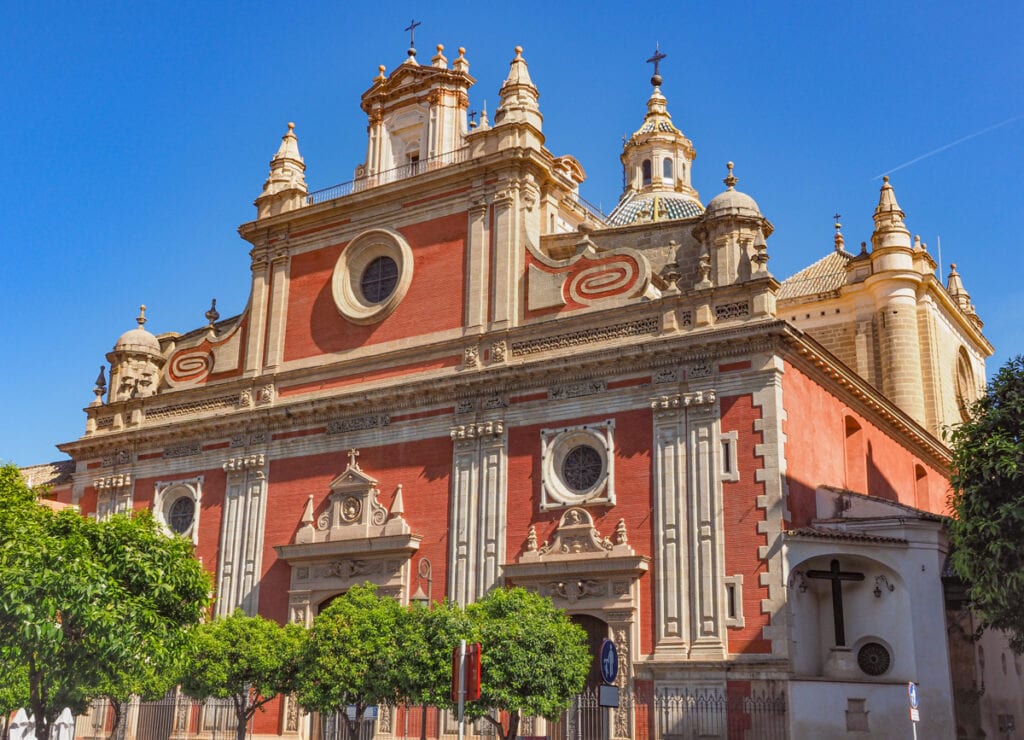
Pro tip: If you haven’t already bought tickets online, you can buy a combination ticket here that includes the Seville Cathedral and La Giralda: the lines are much smaller.
On the other side of the river, the Iglesia de Santa Ana is another must-visit church in Seville. Built in Gothic-Mudejar style, the church is small, with a salmon exterior. It’s often called the Cathedral of Triana and is the oldest church in the city.
The Basilica de la Macarena is a modern church, built in Neo-Baroque style. It houses the famous La Esperanza, the weeping statue of the Virgin. The statue is richly decorated with gems, some reportedly gifted by bullfighters: La Esperanza is considered the patroness of bullfighters and the Romani.
The Iglesia de Santa Cruz is small but beautiful, and easy to visit if it’s open when you stroll the barrio. The facade is classic white with yellow highlights, and the courtyard, with its orange trees, is tranquil. Esteban Murillo, the famous Spainsh painter, is buried here.
21. Tour More Seville Museums
If you are a museum fan, you can go beyond the Seville Museum of Fine Arts and visit some other interesting museums in the city!
We enjoyed our visit to the Archaeological Museum of Seville, housed in the Pabellón del Renacimiento, one of the pavilions designed by architect Aníbal González for the Ibero-American Exposition of 1929.
The most significant thing to see here is the Treasure of El Carambolo, 24-carat gold jewelry from the 6th century discovered near Seville. The treasure also includes a small bronze Phoenician statue of Astarte.
You’ll also see Roman artifacts from Italica, including mosaics and busts, huge vases, tools, and other items.
The Museum of Popular Arts and Traditions is also located in the Maria Luisa Park, across from the Archaeological Museum. The building is stunning, and you can snap photos of it reflecting in the water feature just outside.
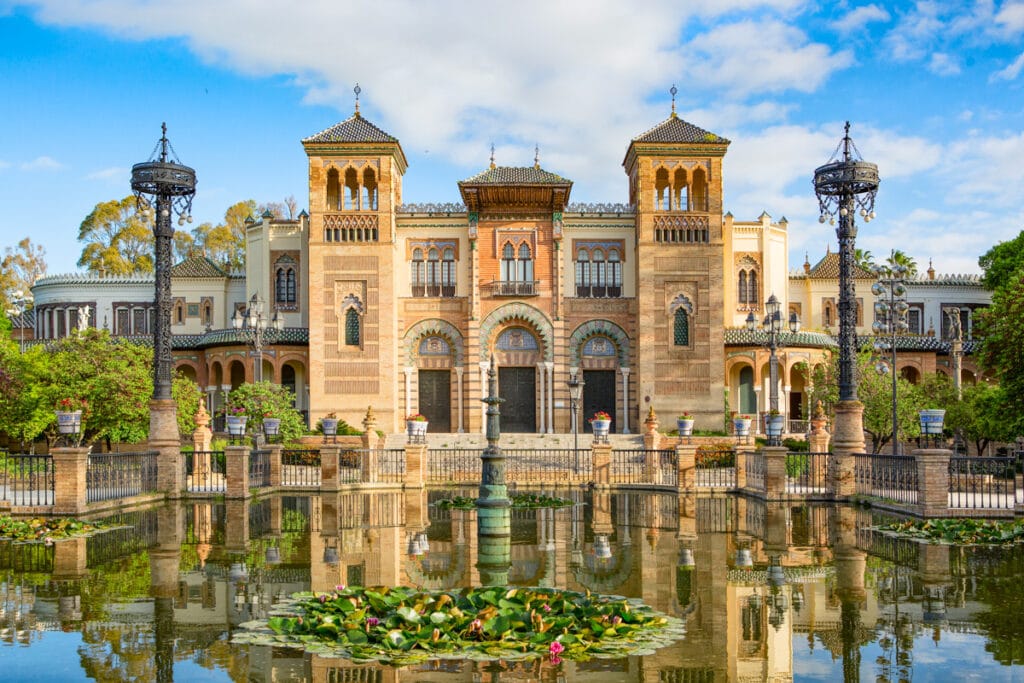
Inside, you’ll find furniture, ceramics, costumes (especially beautiful flamenco dresses!), tools and equipment, and other everyday items that offer peeks into the lives of the people of Andalusia through history.
The Museo de Baile Flamenco is a small museum that showcases the history of the flamenco art form. You’ll find costumes, musical instruments, photos, drawings, and paintings.
The Archivo General de Indias is part of Seville’s UNESCO World Heritage Site. The museum is housed in the historic merchants’ exchange of Seville, a building designed in the Spanish Renaissance style.
The General Archive of the Indies contains invaluable documents relating to the history and expansion of the Spanish Empire in the Indies and the Americas. Look for the journal of Christopher Columbus!
22. Enjoy Isla Magica
If you are traveling with kids, or you need a break from visiting historic sights, head to Isla Mágica.
A theme park in Seville, the Isla Magica complex includes Agua Mágica, a water park that’s very welcome if you are planning to visit Seville in the summer!
The park was built on the island of Cartuja, on the grounds of the Seville Expo 92 World’s Fair. It opened in 1997, and features six theme areas and several thrilling attractions.
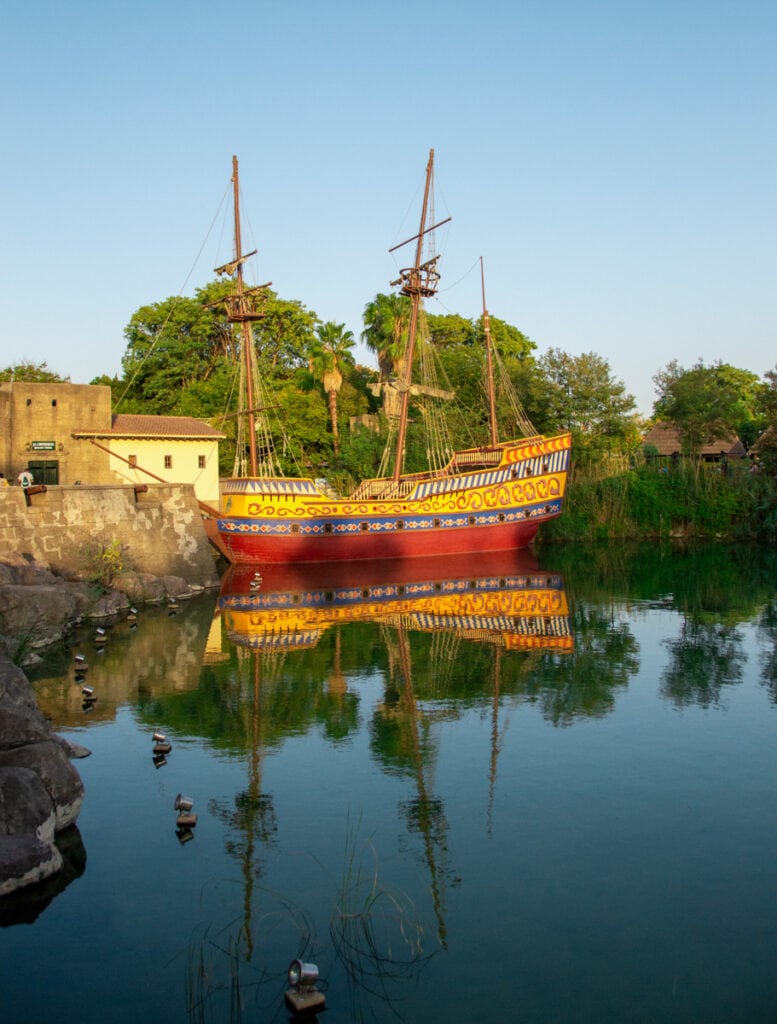
Sevilla, Puerto de Indias, takes you back to 16th century Seville. In the Puerta de América area, admire the Fuerte de San Felipe, and explore the city of Cartagena. In the Guarida de los Piratas, a small inlet, you’ll find swashbuckling pirates and buccaneers.
Enter the Fuente de la Juventud to remain forever young. In El Dorado, discover a lost city sought by explorers and adventurers.
And in Amazonia, enjoy a rainforest as you head to the Jaguar, Spain’s first inverted roller coaster and one of the most thrilling rides in the park.
Isla Magica’s attractions include thrilling rides, kid-friendly rides and a carousel, boat rides and rafting, and a 4-D show. With the variety of attractions and activities, kids of all ages and adults can find things they will enjoy.
Agua Magica offers water slides, zip-wiring over the water, a large swimming pool, a splash pool for small kids, and a beach for sunbathing. You can’t visit the water park on its own, because it is inside the complex.
Isla Magica is very conveniently located: it’s just a 5-minute walk from the city center of Seville. There’s also plenty of parking if you plan to drive.
Pro tip: The park is hugely popular, so you’ll want to use the handy calendar to figure out a less crowded day to visit.
23. Shop for Unique Souvenirs
Want to bring back some souvenirs to remind you of your time in the beautiful city of Seville? There’s lots of choice!
If there’s one souvenir you’ll want to consider bringing back from Seville, it’s ceramics. Stunning hand-crafted ceramics are everywhere in Seville, and Triana, in particular, is still a center of tile and ceramics production in small artisan shops.

Head to Ceramica Triana on C. Callao in Triana for a wide selection and reasonable prices.
From plates, bowls, and Sangria pitchers to decorative wall tiles and plates and flowerpots, the shop has a great selection!
Whether you have room for just one plate or decorative tile, or you want to buy an entire tableware set, you’ll find many brightly colored designs from which to pick.
You’ll also find ceramics in shops in the city center, but you’ll likely pay a little more.
Hand-painted fans, hand-embroidered shawls (mantillas), flamenco dresses, and flamenco figurines are other unique souvenirs to consider.
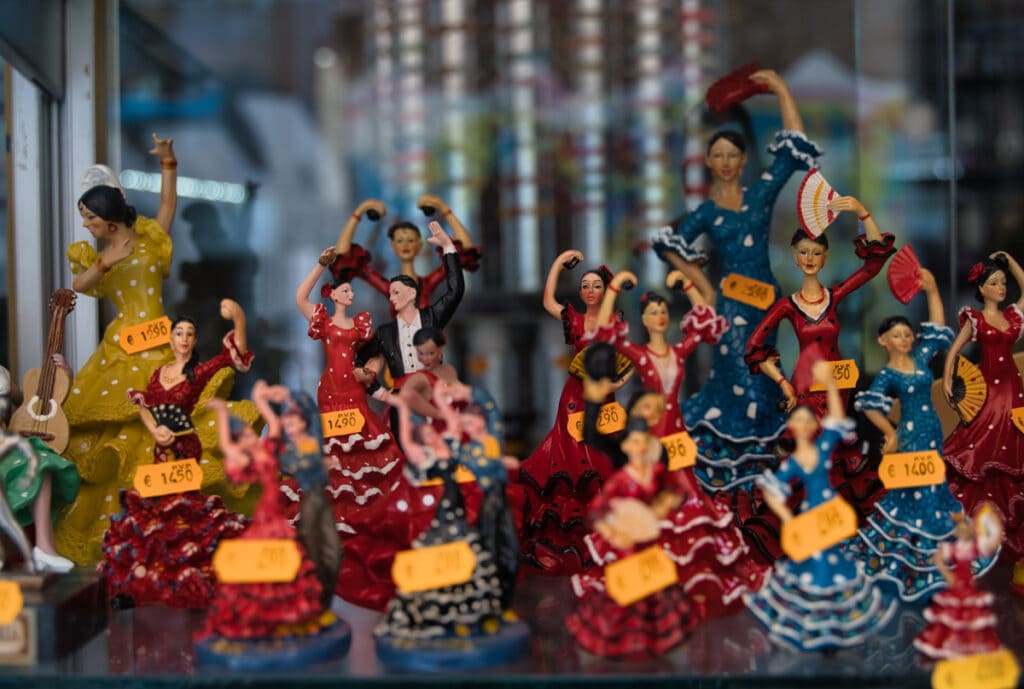
You’ll find fans and flamenco gowns in many brilliant colors, with beautiful designs, and black is the classic color for mantillas, although you may find shawls in other colors as well.
Looking for foodie souvenirs? Look for Spanish olive oils, jamón, cheeses, or orange wine to remind you of the orange trees in Seville!
In the city center, Calle Sierpes is considered a prime shopping street, with both modern and traditional establishments. Be sure to stop by Confiteria la Campana, a historic bakery that has been serving up sweet treats since 1885!
24. Snap Photos at the Pretty Plaza del Cabildo!
The picturesque Plaza del Cabildo is somewhat of a hidden gem in the busiest part of the historic core of Seville.
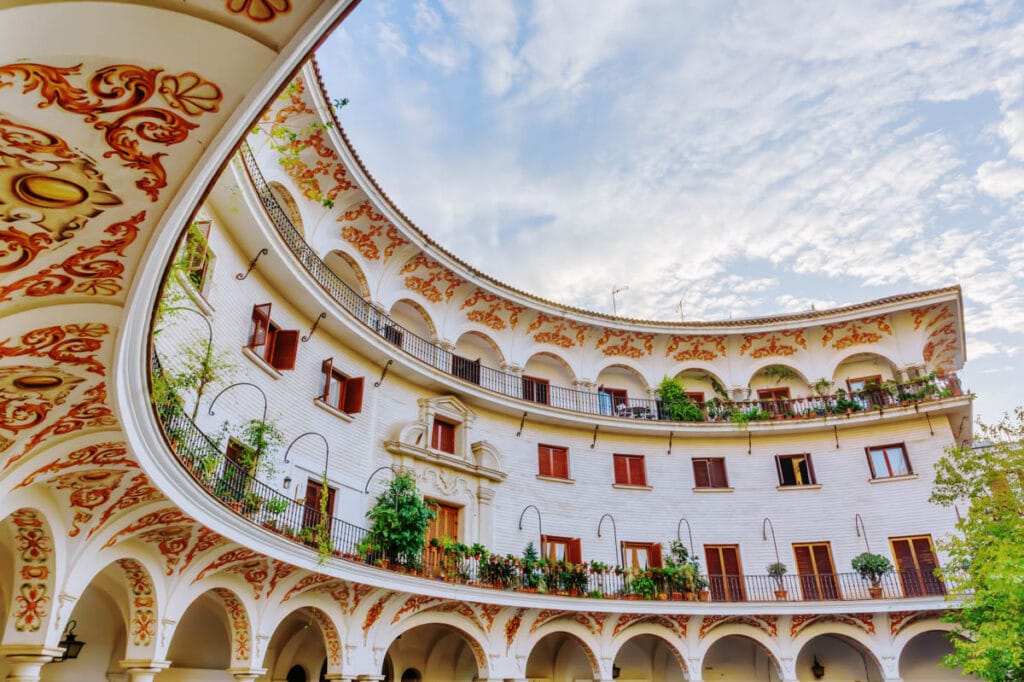
It’s a quick visit to snap some photos on every day of the week except Sunday, when it hosts a flea market that makes for a fun browse, especially for coin collectors, stamp collectors, antique enthusiasts and the like.
The plaza features beautiful architecture, with a semi-circular colonnaded part that has little shops at the bottom and frescoes along the arches and the top.
You’ll also see a remnant of the old city wall that dates back several centuries, and a fountain in the center. The square is tranquil, and you can hear the tinkle of the fountain unless the market is on.
To get to the Plaza del Cabildo, take the passageway across the street from the Seville Cathedral (the Puerta de la Asunción).
Map of the Best Things to Do in Seville, Spain
*****
We hope you found our round-up of the best things to do in Seville useful for planning your trip.
Find out how to put some of these sights on an itinerary with our detailed guide to 3 days in Seville, or our one day Seville itinerary!
Did you find this article informative? Pin it for future reference!
